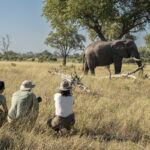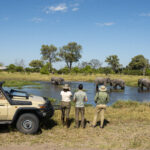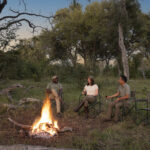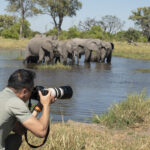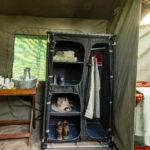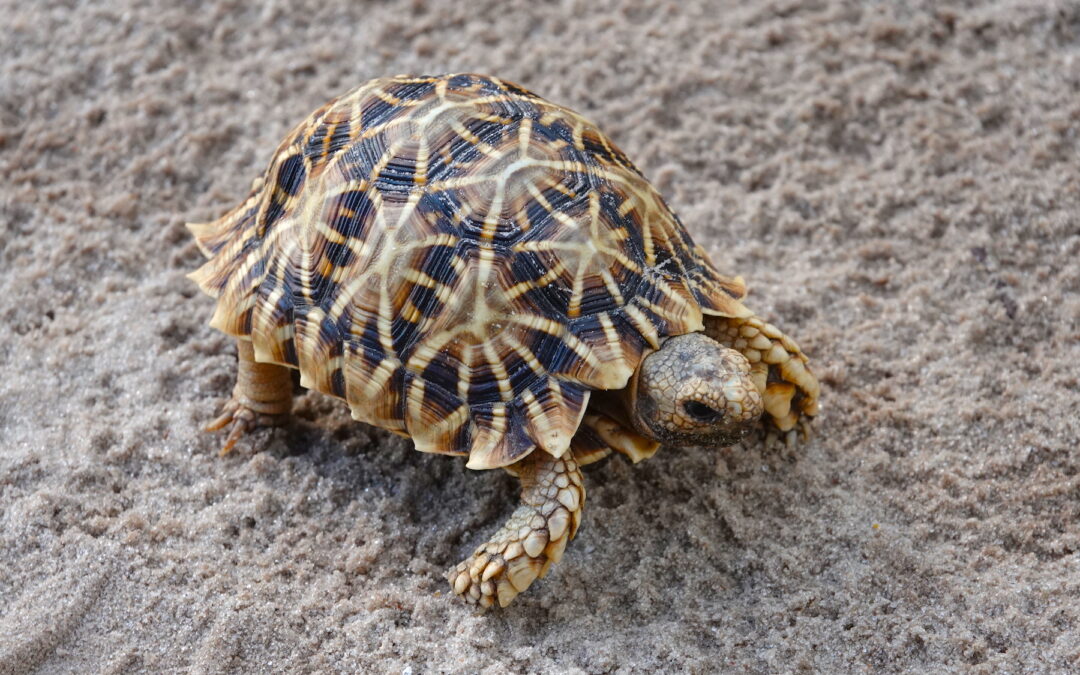
Aug 4, 2020 | Animals of Botswana, Game Drive
Everyone knows about Africa’s big animals. If you’ve looked into going on safari at all, you can probably name Africa’s Big Five. But can you name Africa’s Little Five, and do you know the reason behind the name?
Africa’s Little Five
What are Africa’s Little Five? No, they’re not the five smallest animals in Africa. They’re also not the opposite of the Big Five in that they are the least dangerous animals in Africa. Instead, the “Little Five” are small animals that have matching names to their bigger counterparts—elephant, buffalo, leopard, lion, and rhino.
Africa’s “Little Five” are the:
- Elephant Shrew
- Antlion
- Rhinoceros Beetle
- Buffalo Weaver
- Leopard Tortoise
These must-see tiny animals are just as impressive as Africa’s big game and are remarkable in their own rights. However, we will warn you, it might be a little more challenging to spot these animals on safari, but be sure to ask your safari guide, and he’ll do his best to show you as much as possible.
Elephant Shrew
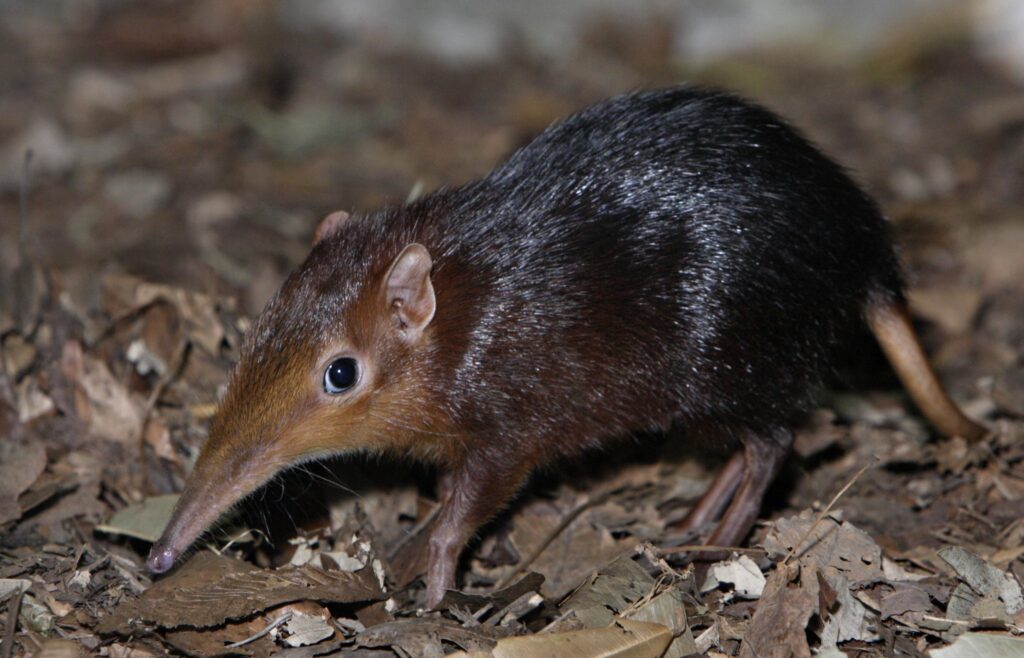
Photo by Smithsonian’s National Zoo—flickr
The elephant shrew is a tiny mammal that eats insects and earns its name from its elephant-like snout. Just 23 – 31 cm (9 – 12 inches) long, this itty-bitty shrew weighs only 680 grams (1.5 lbs). And he is arguably the cutest of Africa’s Little Five.
Elephant shrews can be found throughout Southern Africa. They can thrive in a wide range of habitats from desert to dense woodland. But while they are abundant, they are seldom seen. This little guy is difficult to spot on safari because he is exceptionally shy and swift. In fact, he can reach speeds over 28 kmph (17 mph) and leap almost a meter in a single bound.
As for their “trunks,” they are very flexible and are useful in sniffing out insects. But unlike elephants, they are not very social creatures and live only in monogamous pairs.
Antlion
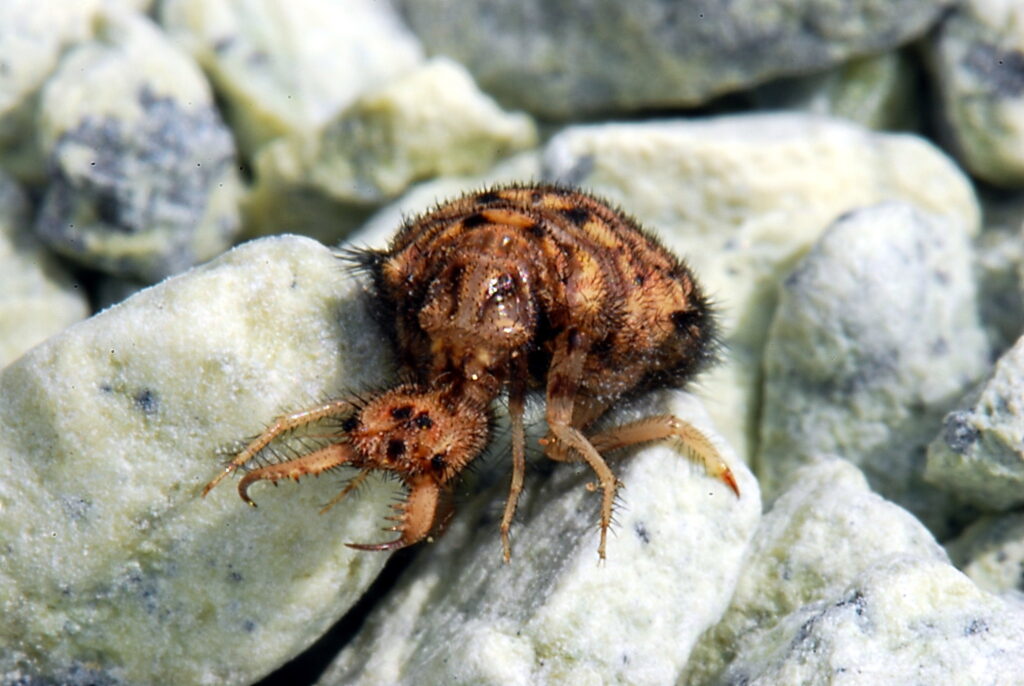
Photo by Mike Keeling—flickr
The antlion is the smallest creature on the Africa Little Five list. They can be found across the globe in dry, sandy regions. But even though there are more than 2,000 different species of antlions, when they reach adulthood, they all resemble dragonflies.
However, antlions are most well known for their larvae (sometimes called doodlebugs). These fearsome-looking creatures are hairy with sickle-shaped jaws and savage temperament. They are capable predators that ambush their victims (typically ants) by lying in wait at the bottom of a crater. As for their scary-looking jaws, they are hollow, which allows them to such their prey dry.
It is the viciousness of their larvae that gives antlions their name. They are as fierce as their lion counterpart.
Rhinoceros Beetle
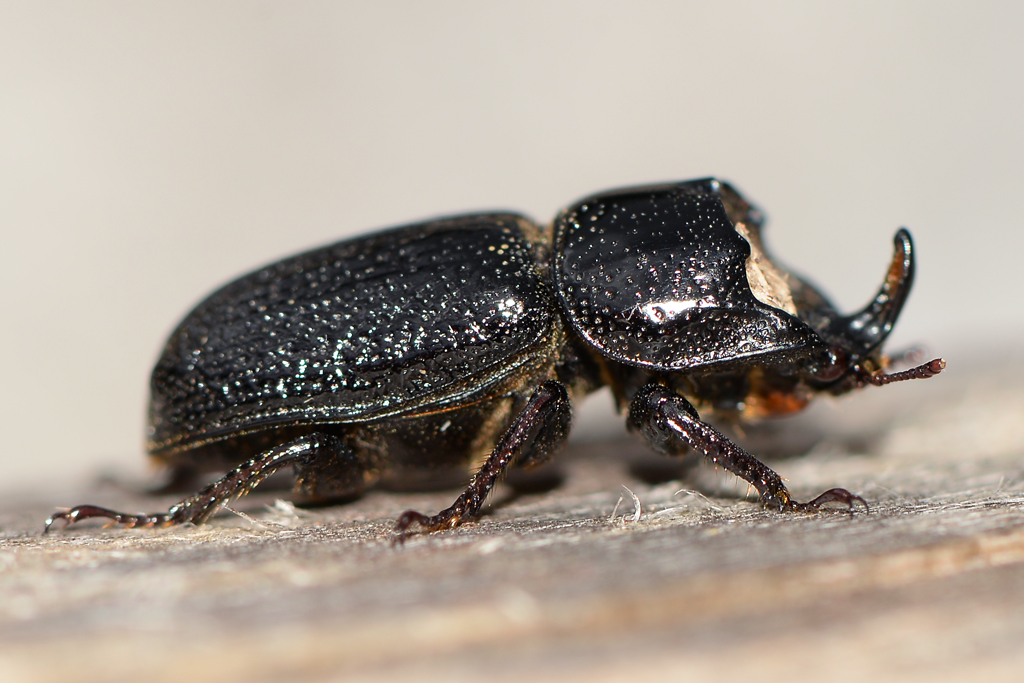
Photo by Kentish Plumber—flickr
The rhinoceros beetle is the next insect within Africa’s Little Five. Belonging to the scarab beetle family, these cool little guys have a self-explanatory name. Male beetles have large hooked horns that they use to fight over territory and dig for food inside rotting trees. And while they look ferocious, they are completely harmless.
Rhinoceros beetles can be found all over the world. There are more than 300 species across the globe, 60 of which can be found in Southern Africa. They can grow up to 15 cm (6 inches) in length, though in Africa, they only reach 5 cm (2 inches). However, their small size does not mean weak. In proportion to their weight, rhinoceros beetles are some of the strongest creatures in the world!
But don’t expect to spot a rhinoceros beetle on your safari. They are only active at night, rarely fly, and spend their time eating fruit, bark, sap, and vegetables.
Buffalo Weaver
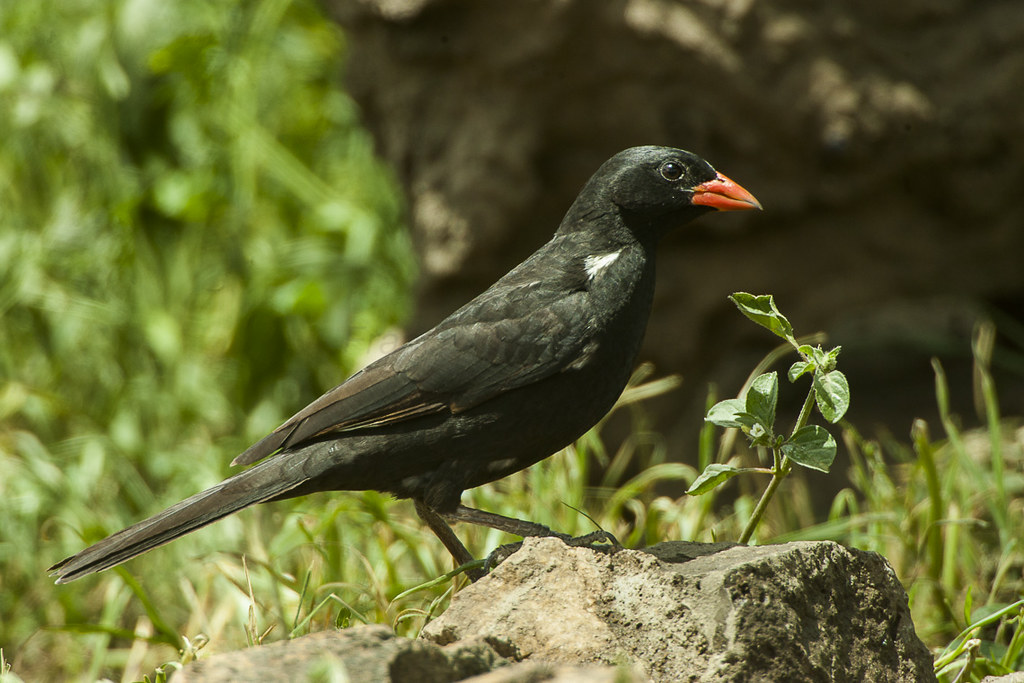
Red-billed Buffalo Weaver photo by Francesco Veronesi—flickr
The only bird on Africa’s Little Five list, the buffalo weaver is a beautiful addition. There are three species, including the white-headed buffalo weaver, white-billed buffalo weaver, and the red-billed buffalo weaver. However, the type you’ll see depends on where you visit. All three species live in Eastern Africa, but Southern Africa is only home to the red-billed buffalo weaver.
The good news is that the buffalo weaver is common and easy to spot. They are highly vocal birds that live in loud, boisterous colonies. They are also fairly large, growing up to 24 cm (9.5 inches) in length. Their name comes from the intricate nests they weave from small sticks and dry grass.
You’re most likely to find a buffalo weaver in areas of dry savannah and scrubland, and living on a diet of seeds, fruit, and small insects, including scorpions.
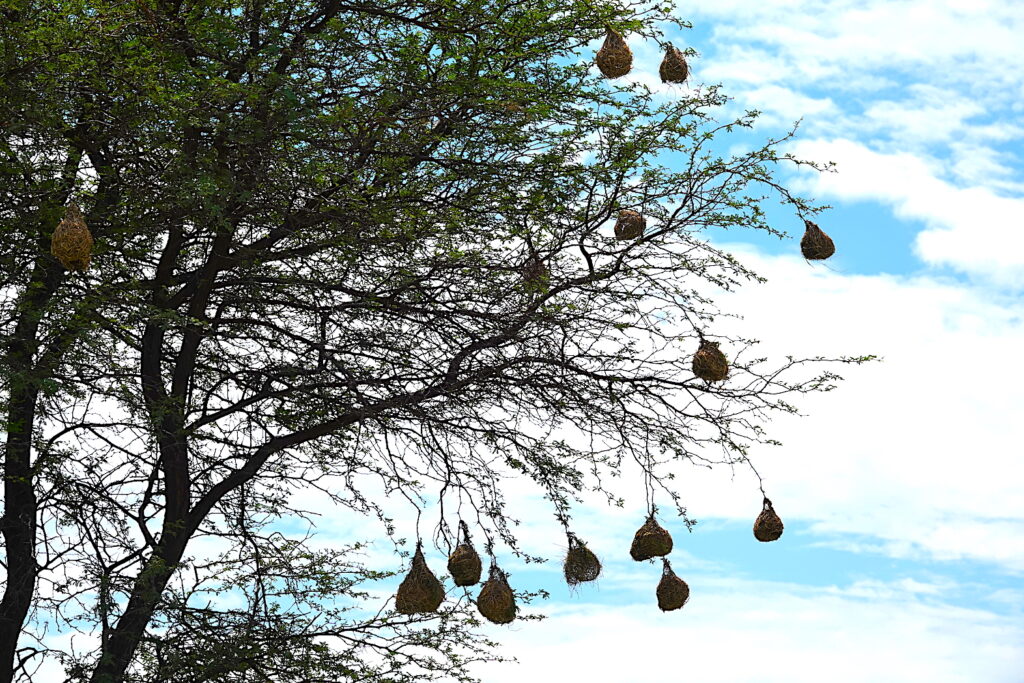
Buffalo weaver nests
Leopard Tortoise
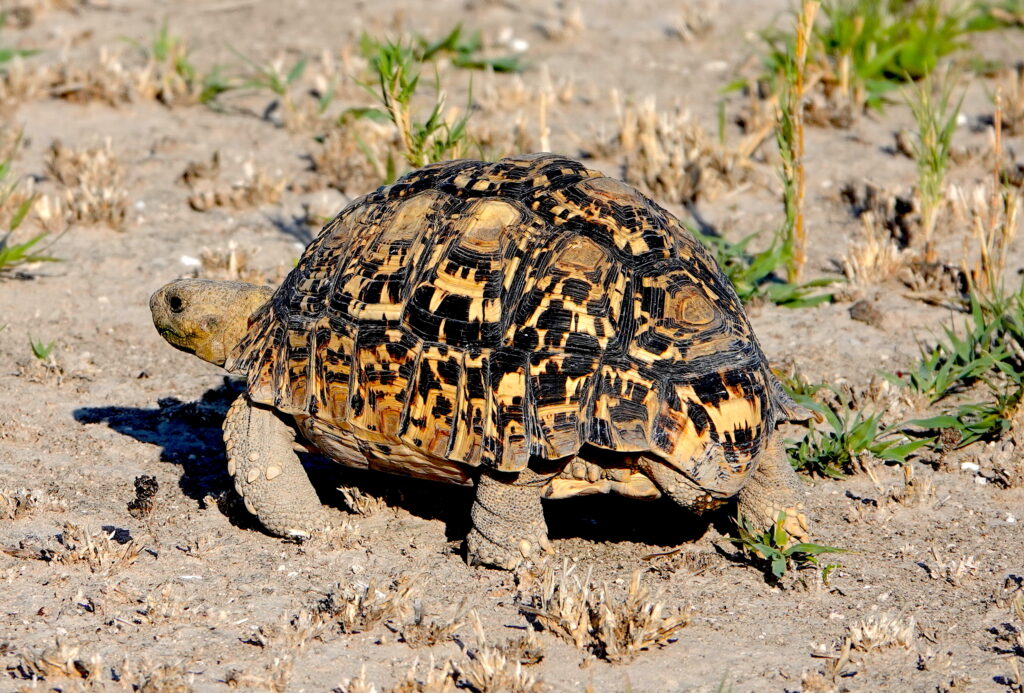
Photo by Brave Africa
Our favorite animal on Africa’s Little Five list is the leopard tortoise. These cool guys can be found throughout sub-Saharan Africa, though they prefer semi-arid environments such as scrubland and savannah. They graze on grass and burrow under the ground for safety and in bad weather.
Of course, they get their names from their colorful and unique shells. They have unique gold and black markings that resemble the rosette spots of a leopard. Each shell is entirely unique and exceptionally hard. They are highly resilient creatures able to climb, swim, and live up to 100 years.
You’ll most often discover leopard tortoises on the road. They are solitary creatures that grow up to 100 cm (39 inches) long, making them the fourth largest tortoise in the world.
Small Safari Animals
As we’ve said before, going on an African safari isn’t just about seeing the big game that everyone knows. From almost two-dozen different types of antelopes to wild dogs, hyena, giraffes, zebra, and more, there are always some amazing animals to see and experience.
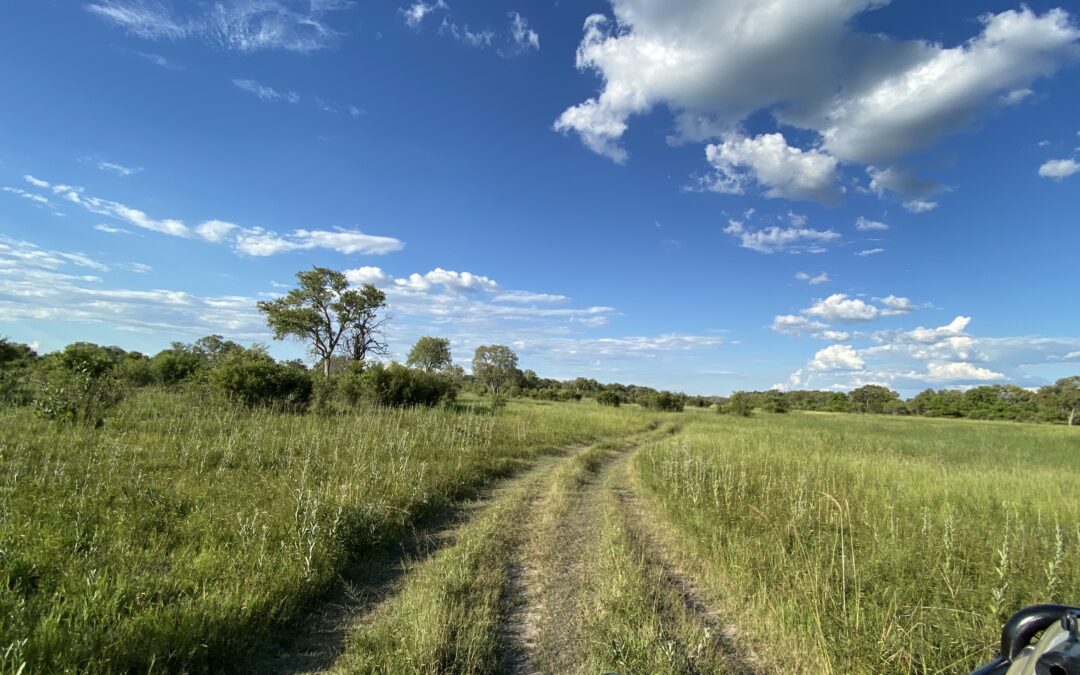
Apr 24, 2020 | Adventure Safari, Animals of Botswana, Coronavirus Content
Are you bored stuck in quarantine? We completely understand. It’s tough right now to stay entertained while locked inside, but we have a solution. In honor of Earth Day (April 22, 2020), we gathered our five favorite African nature documentaries to watch during COVID-19.
All of these documentaries offer something unique and exciting to enjoy while you’re sitting on your couch and wondering what’s on TV. Some are focused on Botswana’s Okavango Delta, while others are more wide-ranging and document nature from across the globe. Whatever the case, they all offer unique insight into the beautiful continent that is Africa.
1. DisneyNature Elephant
This kid-friendly nature documentary follows a family of elephants as they journey through Botswana’s Okavango Delta in search of food and water. Narrated by Meghan Markle, the Duchess of Sussex, it’s a charming story of the struggles and joys of being an elephant and surviving all that nature has to offer—the good and the bad.
It’s a story-driven African nature documentary that is perfect for kids who may get bored with typical nature shows that are too fact-focused. Telling the tale of matriarch Gaia, her sister Shani, and Shani’s son, Jomo, Elephant takes a fun look at the journey many elephants in the Okavango Delta go through every year to stay alive.
You can find it on Disney+. And we highly recommend the behind-the-scenes story In the Footsteps of Elephants if you want more insight into Botswana and what it took for filmmakers to get the shots they did.
2. Night on Earth
Night on Earth, which you can watch on Netflix, might be one of our favorite new nature documentaries. The series offers viewers an entirely new look at animals, under cover of darkness. It’s absolutely incredible to see big cats, bears, bats, and other creatures as they explore their world in a way you’ve never seen before.
From cheetahs hunting in the African savannah to monkeys trying to survive freezing temperatures in Japan, Night on Earth reveals the magic that happens after the sun goes down. It’s an addicting new nature series that we highly recommend.
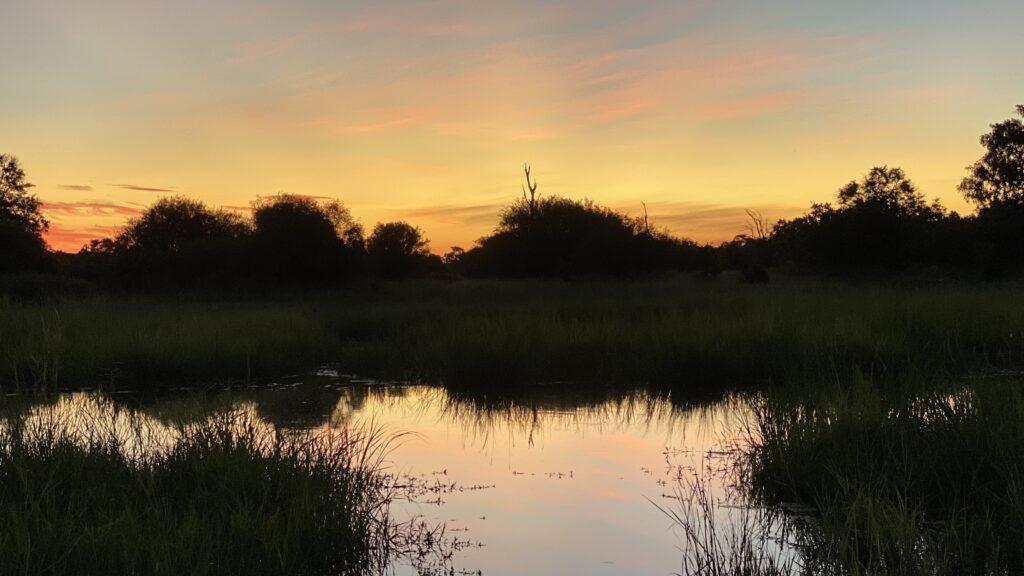
The first episode, in particular, is highly focused on Africa and big cats at night. Watch it on Netflix.
3. National Geographic: The Flood
If you want to get an up-close and personal look at Botswana’s Okavango Delta, The Flood is the National Geographic special you MUST watch. When we sat down to enjoy this, we were amazed at how much of what they showed matched what we’ve witnessed in the Delta ourselves.
This African nature documentary truly shows the spectacular beauty that can be found in Botswana. There is no place like the Delta anywhere else in the world. Each year the cycle of flooding and desert creates a symphony of life that takes your breath away. And The Flood gives you an in-depth look at this miracle and all it has to offer.
If you want to truly see what it’s like to go on safari with Brave Africa in the Okavango Delta, this is the documentary you want to watch. It’s probably the closest you can get to actually going on safari. Watch it on Disney+.
4. The Ivory Game
Every 15 minutes, an elephant is killed. Many of these elephants are killed for their tusks. The illegal ivory trade is a terrible and thriving business that claims thousands of elephants every single year, and The Ivory Game takes you into that dark world for a close-up look.
This African nature documentary is not for the faint of heart. It’s a dark story about the illegal ivory trade, the consequences it has, and what’s being done to stop it. It’s a herculean effort that’s constantly ongoing and desperately deserves our attention.
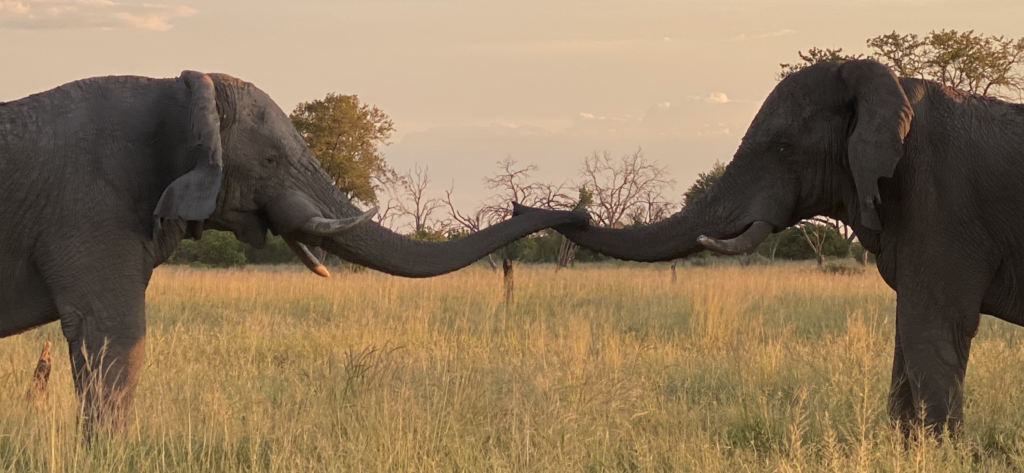
If you want to know more about the challenges facing elephants and conservation efforts. Watch it on Netflix.
5. National Geographic: Savage Kingdom
With three seasons already available to watch, National Geographic’s Savage Kingdom is a fantastic TV show. It takes you into the heart of Botswana’s Savuti to show you life as a predator. The episodes follow the kings and queens of the African savannah—lions, hyena, cheetah, leopard, wild dogs, etc.—as they battle it out to be on the top of the food chain.
Narrated by Charles Dance (best known for his role as Tywin Lannister) it’s an epic TV series that not only shows you the beauty of Botswana’s Savuti marsh but also its harsh reality. Life isn’t easy for the predators or the prey in this vast, unforgiving land.
Unfortunately, this amazing show is only available if you have Hulu+ Live or you can buy each season on Amazon Prime for $14.99.
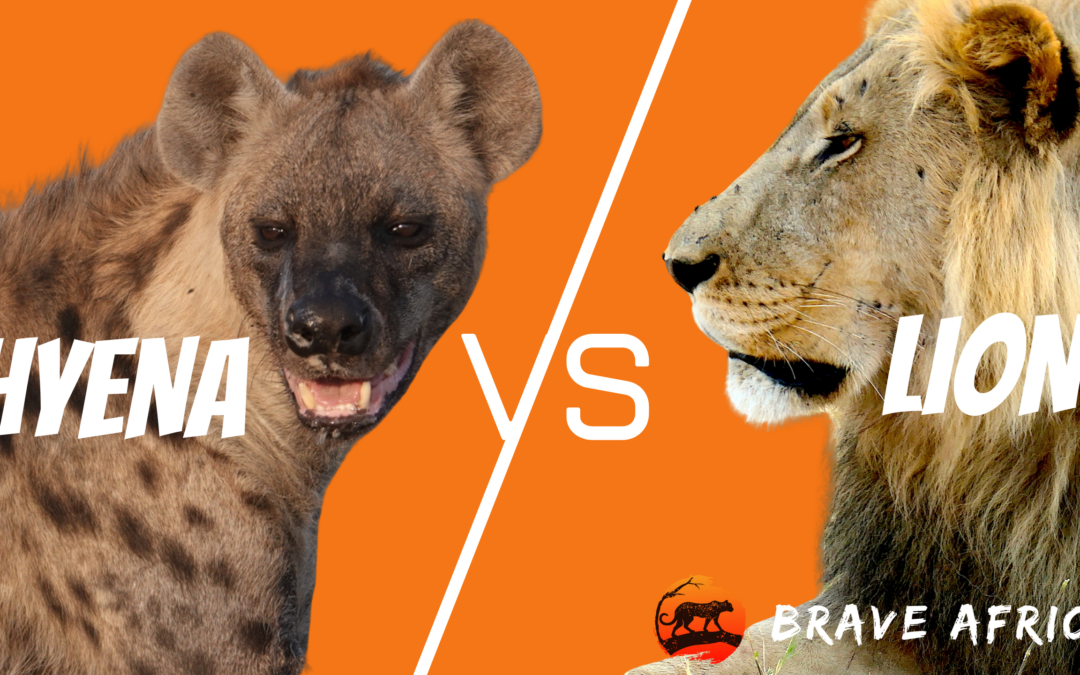
Apr 17, 2020 | Adventure Safari, Animals of Botswana, Brave Africa Safari, Game Drive, Most Popular Blogs
Before the coronavirus pandemic, the Brave Africa team was lucky enough to be out in the Okavango Delta for 18 days in March with a guest. Throughout the trip, they had many incredible Botswana safari sightings. Still, one lion sighting really stood out: a small pride of lions versus a lone hyena fighting over a buffalo kill.
Here’s the story of our incredible lion VS hyena battle from our co-founder and expert guide, Tabona Wina.
Flooding in the Okavango Delta
The bush was amazing!
It was so beautiful, and the game was incredible. While we can almost always say that about the Okavango Delta, during such an early and robust flood season, it is even more true.
Water was everywhere while we were on safari. In fact, it was so flooded that if it weren’t for COVID-19 closing down everything anyway, there’s a good possibility that the government may have had to close down certain sections of the Moremi Game Reserve and Khwai for safety reasons.
It was actually difficult to drive to many areas because the water was so deep and spreading. It was a marsh wonderland, which brings many interesting challenges and opportunities.
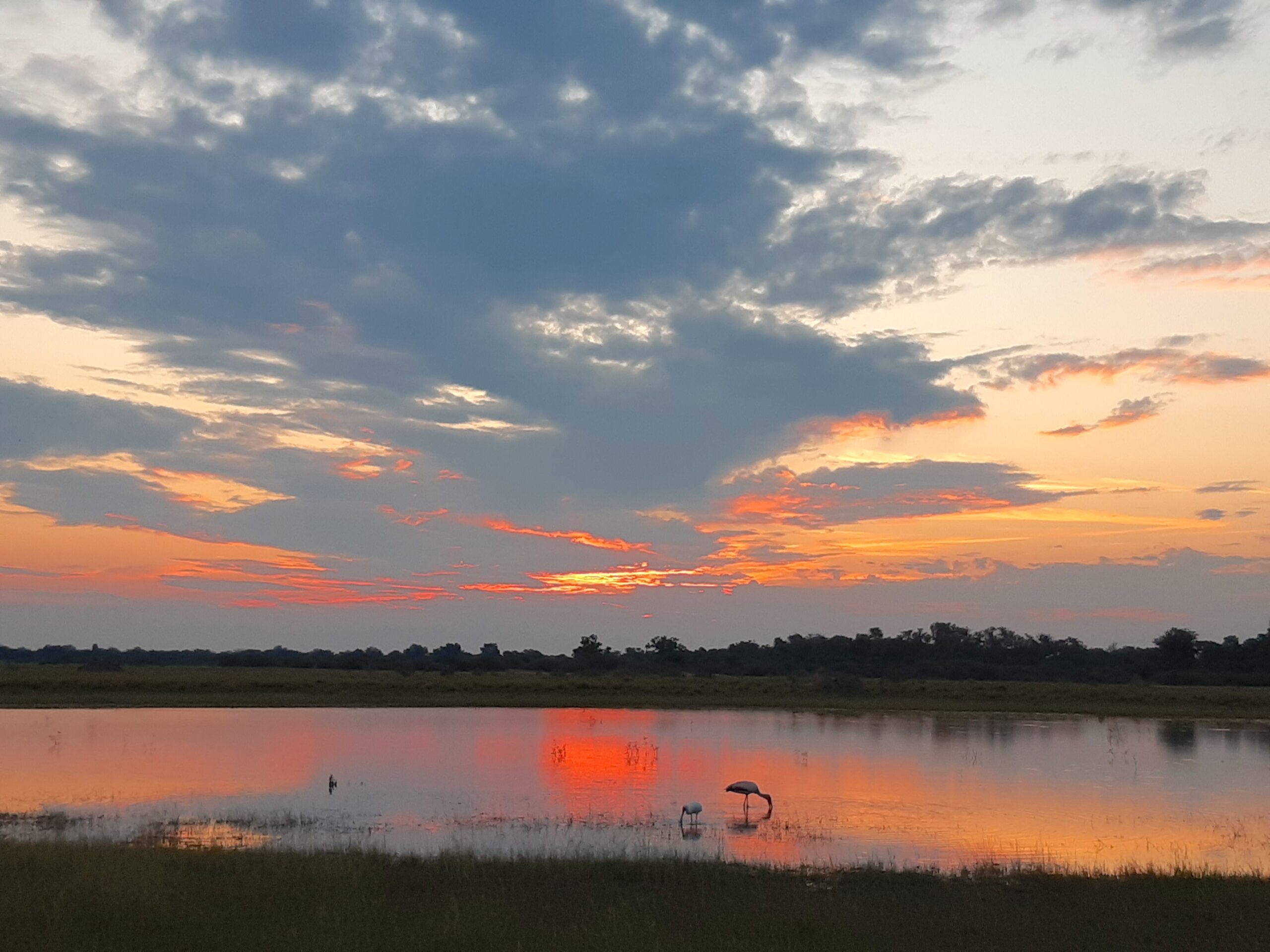
When it floods early, the areas where the game roams shrink drastically. Basically, the floods create hundreds of small islands where there’s no water, and it’s possible to hunt and forage. This brings the predators and their prey into close proximity, which can provide some amazing Botswana safari sightings.
It’s especially true for the animals in the Okavango Delta who are highly adapted to flooding. They know how to cross from island to island in search of safety and food. As a safari guide, if you know where to go and can get there, there’s no end to the incredible sightings you can have.
Lion VS Hyena
Lion King pitted lions vs hyena and made the hyena out to be the bad guys. That’s not quite true in nature. While lions and hyena do not get along—they are both predators and thus competitors—they aren’t necessarily enemies that will kill each other at the slightest provocation. And that’s something we got to see in person.
One morning, after our usual coffee and breakfast, we headed out to the bush in search of something special, and within a few minutes, we found it.
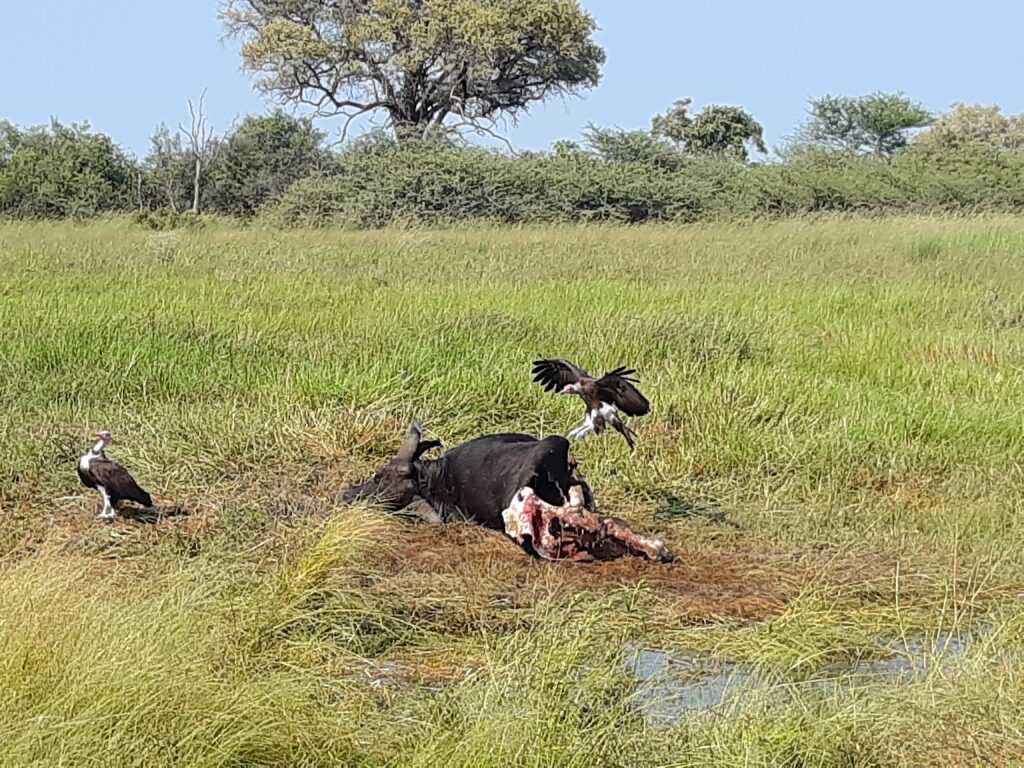
The lions’ buffalo kill.
We discovered a small pride of three lions—two females and a male—huddled around a buffalo kill. They were enjoying their successful hunt, immensely, and eating as much as possible. Of course, with blood on the air, it was inevitable that hyenas would show up.
Two male hyenas prowled at the edge of the kill, well out of the way of the much larger and dangerous lions, but they were just biding their time. And eventually, they found their chance. When the male left the kill—bellies full—and found a bush in the shade to rest, the one bold hyena tried his luck.
It was like a National Geographic sighting. The bold hyena went straight up to the buffalo carcass and started eating. While the females weren’t happy and circled the kill and the hyena a few times, as long as they stayed on opposite sides of the body, they allowed the hyena to enjoy the kill, too.
Eventually, one of the lionesses even relaxed enough that it seemed like she didn’t care at all that the hyena was there at her kill. But that was NOT the case for the male.
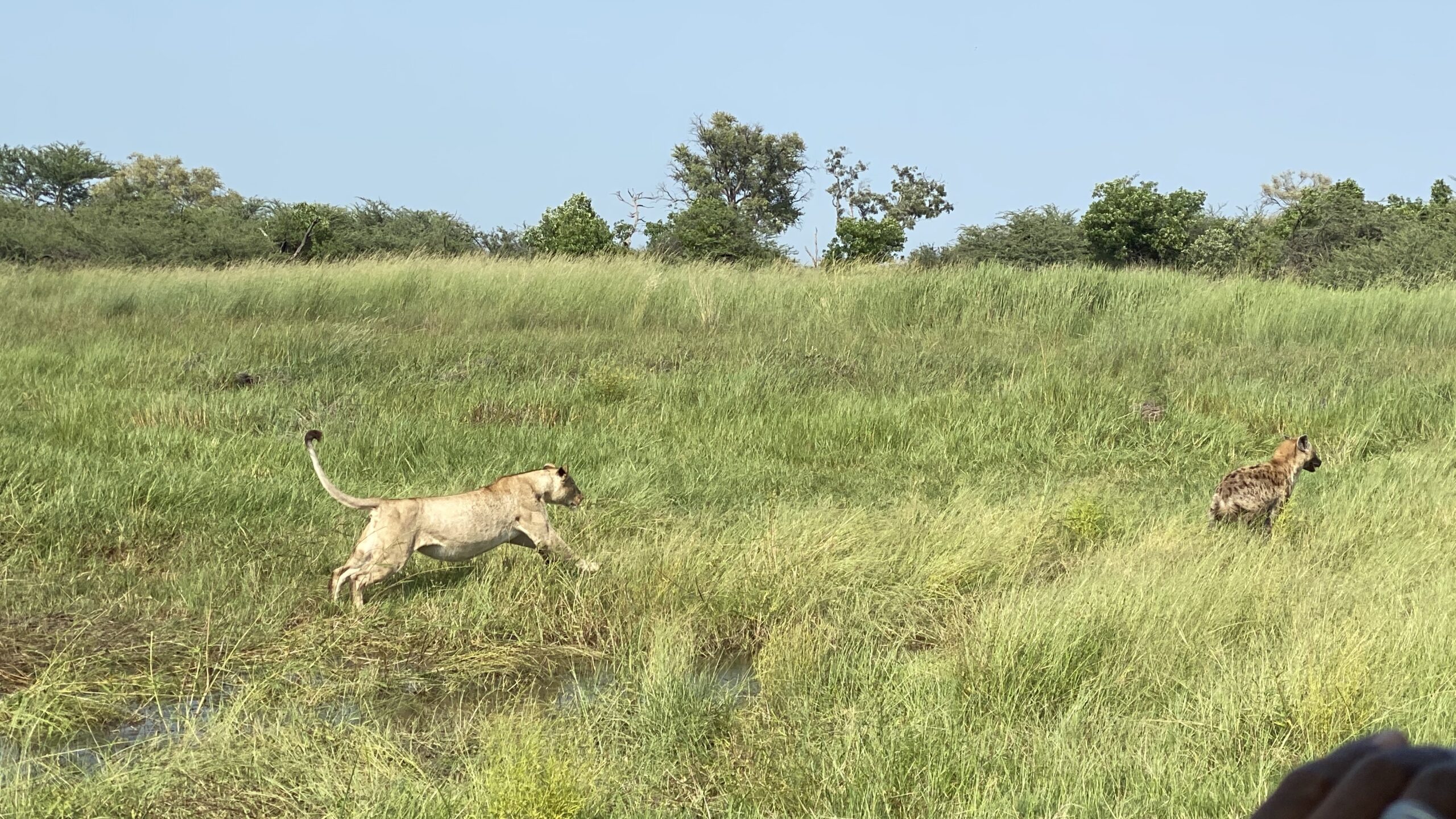
From the shade, he watched the entire situation played out, and after a while, decided that he might be full, but he would not allow a hyena to eat what was his. He broke away from the shade and chased the hyena off.
From that point forward, the lions decided that the hyena was no longer allowed around the kill, and no matter how persistent he was, he was chased off over and over and over again.
It was beautiful to watch, and we spent the entire morning with the lions and hyena.
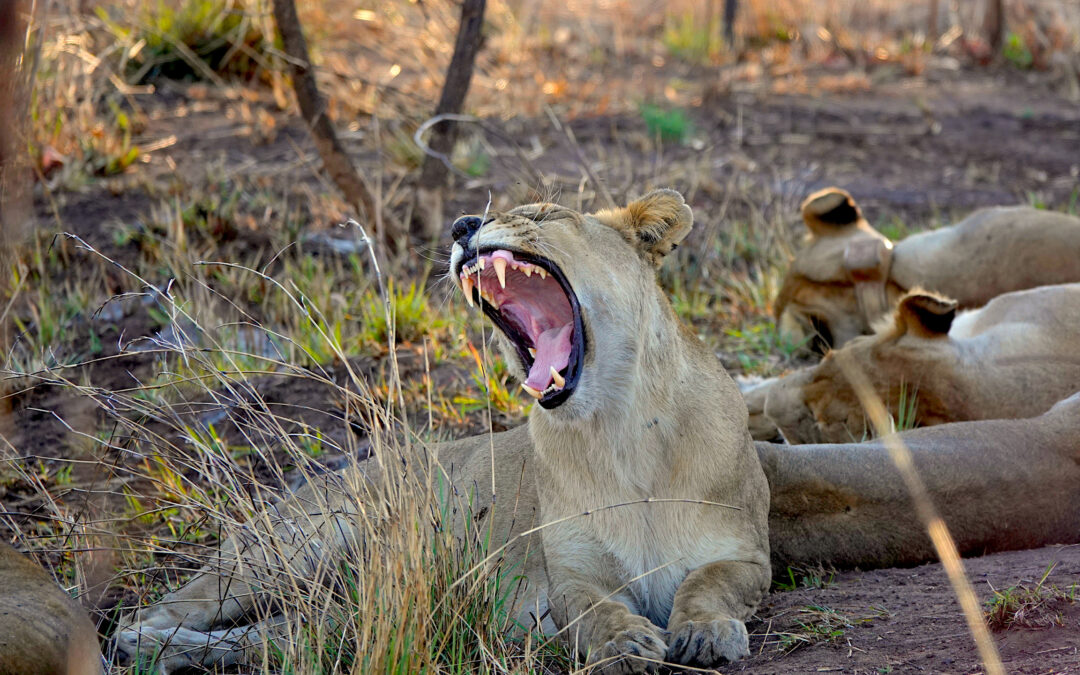
Apr 2, 2020 | Animals of Botswana, Conservation
Seeing big cats on safari is the dream! After all, who wouldn’t want to sit beside a lion, watch a leopard hunt, or stand in awe of a cheetah’s run? But did you know that there are more cats in Botswana than you might think?
As the next submission in our Brave Africa blog series Animals of Botswana, we’re tackling all of Botswana’s cats—big and small. Get to know all the different types of cats you could enjoy and why we love them. You could see many of these on your next game drive with us!
Lion
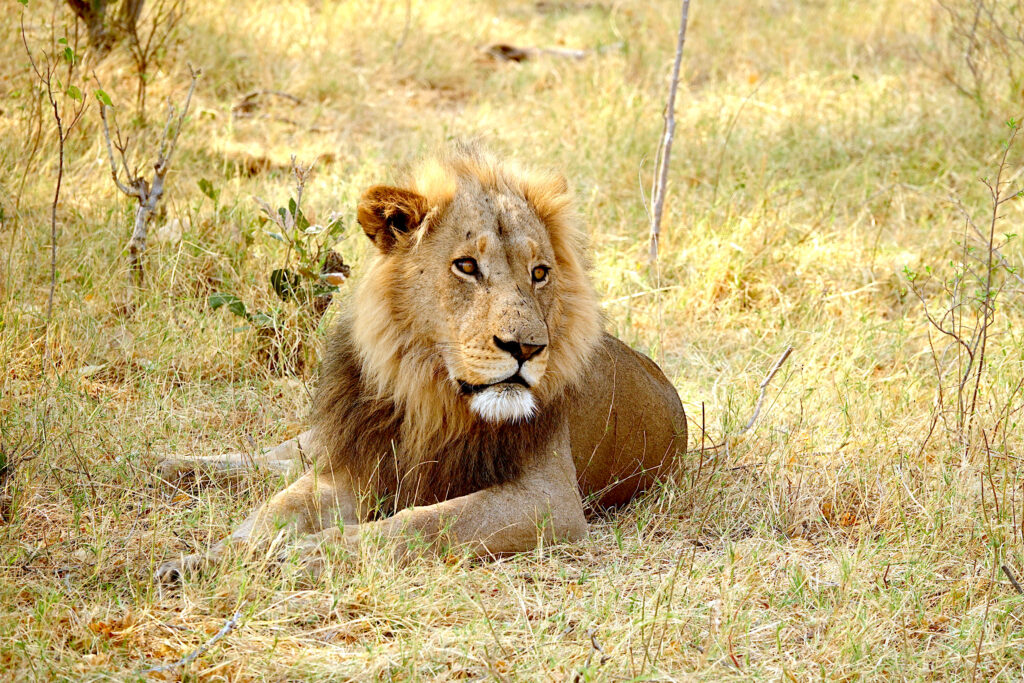
The largest lion on record weighed 375 kg (826 lbs).
Lions are the kings of the African bush. As an apex predator, they roam the open savannahs and grasslands of Botswana, looking for prey. They are the second-largest cat in the world, known for their strength, ferocity, and laziness. J Unfortunately, they are also becoming rarer and rarer in the wild. There are only about 20,000 African lions left, and they are listed as “Vulnerable” on the endangered species list. In Botswana, these cats are fairly prevalent with the second-largest population in all of Africa.
How to recognize lions:
Lions are easy to identify because they are massive, weighing up to 180kg (400 lbs)! Here are a few more characteristics:
- Lions have yellow-gold fur that’s generally short. Adult males typically boast a mane of long, brownish hair encircling their heads.
- Lions roar to declare territory, ward of rivals, call for backup, and communicate with their pride. Their roar can be heard up to 8km away.
- Lions are well-muscled cats with long bodies, large heads, and short legs.
Where can you find lions?
Lions can be found all across Botswana’s wilderness from the arid desert of the Kalahari to the swamplands of Moremi and the grasslands of Savuti. You’ll find lions both as solitary individuals as well as in prides of up to 40 lions. While lions can live and hunt in almost any habitat, they prefer grasslands, shrubs, and open woodlands.
Leopard
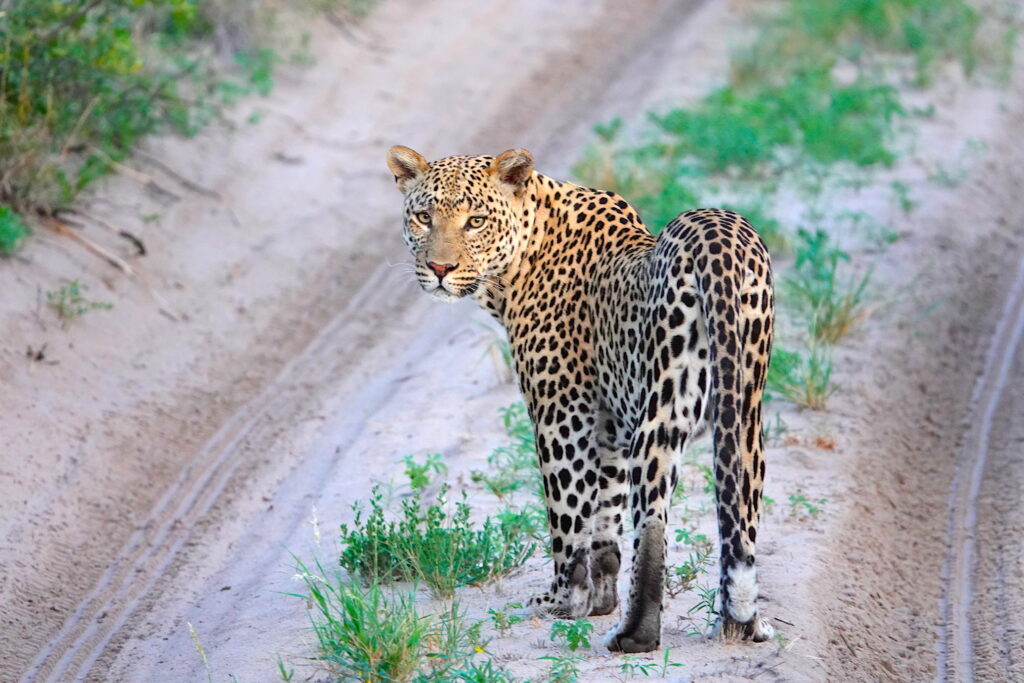
Leopards are highly skilled climbers that use trees to keep prey from scavengers.
Leopards are some of the most elusive cats in all of Africa. They are nocturnal predators known for their exceptional night vision and climbing abilities. They are graceful hunters that are also incredibly adaptable. They aren’t just found in Africa. You can find leopards all over the world in a diverse array of climates, from jungles to forests and deserts across India, China, Central Asia, and Africa.
How to recognize leopards:
Arguably, leopards are one of the most beautiful cats in Botswana and all of Africa, but they are very secretive. That’s why it’s essential to know how to recognize them.
- Leopards are known for their light yellow fur covered in distinctive spots known as rosettes. These irregular dark spots are circular or square in shape and sort of look like roses.
- Leopards are medium-sized cats weighing between 24 to 53 kg (53 – 115 lbs) and are extremely muscular.
- Leopards make a very distinctive hoarse, raspy cough sound to communicate with their young and mark their territory. They can also hiss when threatened.
Bonus: Some leopards can be completely black, although this is a rare coat color that’s the opposite of albinism.
Where can you find leopards?
Botswana leopards enjoy a wide range of habitats from dense bush to forests. They enjoy both hot and cold climates, including semi-desert regions. You can find leopards on the ground as often as they are in the trees, although if they’ve made a recent kill, their dinner will almost always be in a tree to keep it out of reach of scavengers.
The most common of Botswana’s cats, leopards can be found all over, but your best chances are in the Moremi Game Reserve. However, it’s important to note that a high concentration of lion means it is less likely you’ll see a leopard, as it is too dangerous for them to hunt.
Cheetah
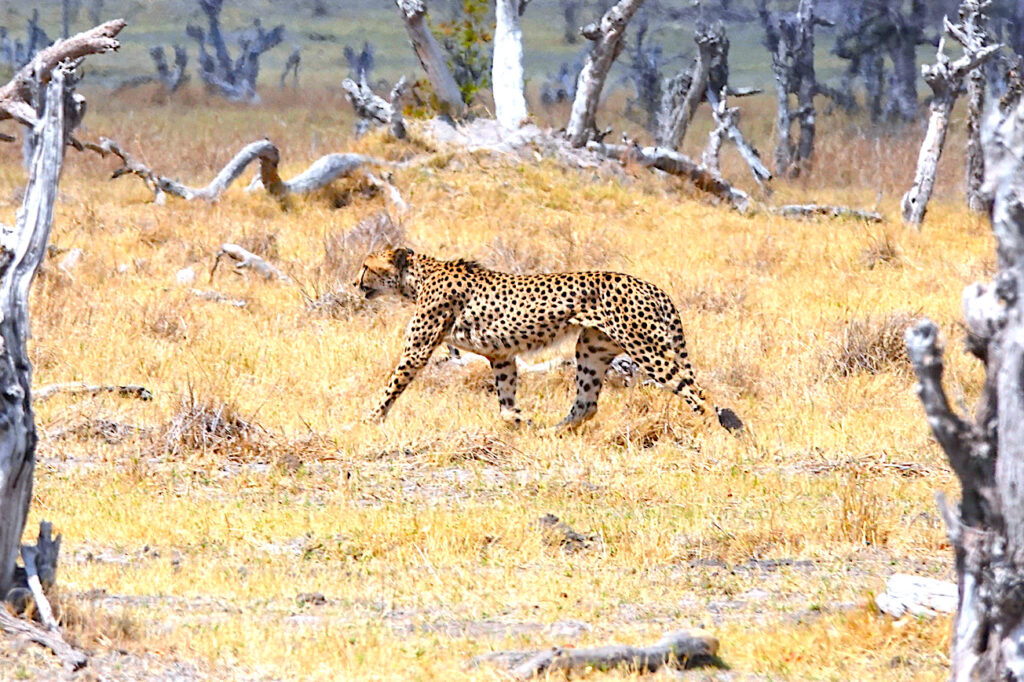
Cheetahs can accelerate faster than a sports car, reaching up to 112 km/hr in three seconds.
Cheetahs are some of the smallest of the big cats in Botswana, but they are also the fastest. They can go from 0 to 96 kilometers an hour (60 mph) in just three seconds. Even at these high speeds, cheetahs are very agile and can make sudden turns to catch their prey. They have exceptionally keen eyesight, which makes them one of the few big cats that prefer to hunt in the daylight.
How to recognize cheetahs:
As the fastest land mammal, cheetahs can be hard to come by. They are solitary by nature and highly timid, which means you have to be very lucky to see one.
- Cheetahs are smaller cats weighing between 34 and 57 kg (75 – 125 lbs). They have a thin frame, a narrow waist, and a deep chest, giving them the appearance of a long, very slender body.
- Golden in color, cheetahs have solid black spots and very distinctive black facial strips running from their eyes, which almost look like tears.
- Cheetahs are very vocal. They purr when content, and growl, hiss, spit, moan, and yowl in danger, annoyance, or to threaten other predators. One of their most distinctive sounds is the chirp, which they use when excited. It can be heard up to 2km away.
Where can you find cheetahs?
Cheetahs are nomads by nature, which means they never stay in one place for long and can cover vast distances in search of prey. They can most often be found in wide-open grasslands where it’s easier to run after prey as needed. However, because it takes a large amount of energy to catch and kill their prey, they prefer to hang out in the shade to preserve what energy they can.
Botswana is home to 25% of the world’s remaining cheetah population and is the ONLY country where the population remains stable. They can be found throughout the Okavango Delta in any area where there are open plains. Savuti typically offers your best chance.
Serval
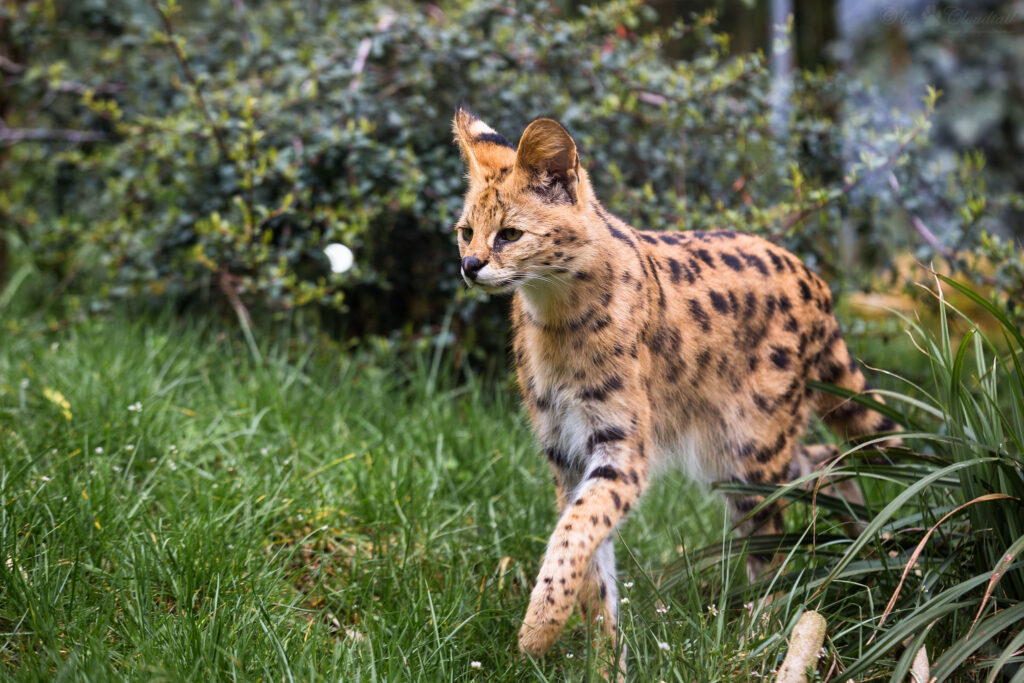
Serval cat image courtesy of Cloudtail the Snow Leopard (Flickr).
Beyond the big cats, there are also medium-sized wild cats, such as the serval. These seldom-seen predators prey on mice, rats, and other small animals, including young antelope. They use their big ears to locate prey by sound and then use their legs to run through tall grass and pounce. They are a swift and agile Botswana cat that leaps very well and hunts mostly at night.
How to recognize servals:
Servals might be common throughout Africa, but because they prefer to live and hunt in bush, tall grass, and in dry reed beds, they are hard to spot. That means it’s essential to know what they look and sound like.
- Servals are medium-sized, slender cats, weighing between 9 – 18 kg (20-40 lbs). They have small heads, large ears, and the longest legs of any cat relative to their body size.
- They are characterized by having golden coats spotted and striped in black, including a short, black-striped tail.
- Servals are solitary cats that are incredibly territorial. That’s why you’ll hear chirps, purrs, hisses, snarls, and growls.
Where can you find servals?
Servals are active in both the daytime and at night, meaning you can see them at almost anytime. On top of that, they are listed as one of the animals of “Least Concern,” according to the IUCN Red List. However, that does not mean you’ll see a serval. Because they are smaller, they are more difficult to find, especially considering they prefer wetter areas with long grass.
You’ll have your best chance of encountering a serval in northern Botswana. They can be found in Khwai and throughout the Okavango Delta as well as in the Linyanti, Kwando, and Savuti areas. Most often, good sightings occur during night drives.
Caracal
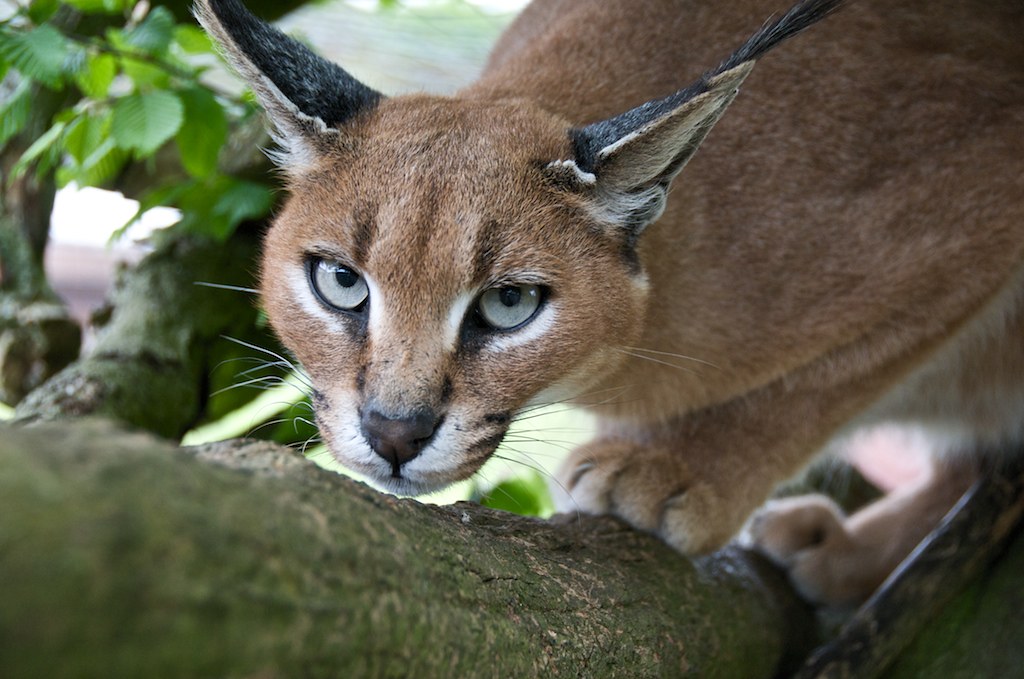
Caracal image courtesy of Andrew Halliday (Flickr).
Another rare, medium-sized cat that you might run into is the caracal. This highly secretive cat is difficult to observe, particularly since they live alone or in pairs and are active mostly at night. They are excellent leapers that can catch birds in midair, but also hunt rodents and small antelope. Remarkable hunters for their size, caracals are characterized by their ability to get within a meter of prey before pouncing.
How to recognize caracals:
Caracals are sleek cats built for sneak attacks. And they are super fast and almost silent, so seeing one in the wild is a very rare opportunity. Here’s how to recognize a caracal.
- Caracals have a robust build with long legs, short faces, and long-tufted ears. They weigh between 8 – 18 kg (18 – 40 lbs).
- Their coat is uniformly reddish tan or sandy with some lighter sections on their stomach, neck, and jaw.
- Like many smaller wild cats, they make a variety of sounds, including purrs, mews, growls, and hisses. However, these guys are mostly silent except for a “wah-wah” sound that they make when uneasy.
Where can you find caracals?
You can find caracals throughout sub-Saharan Africa. They have adapted to a wide variety of environments, which is why they are of “Least Concern” when it comes to endangered species. They mostly prefer to live in dry areas with low rainfall and lots of cover. That’s why you’re more likely to find them in savannas, marshy lowlands, semi-deserts, and scrub forests.
Your best chance of seeing a caracal—one of Botswana’s cats—is during a night drive or in the early evening. Areas such as the Kalahari and Savuti would provide the best chance of a sighting, but it is very rare.
https://www.youtube.com/watch?v=V4e6PsA6mmI
African Wildcat
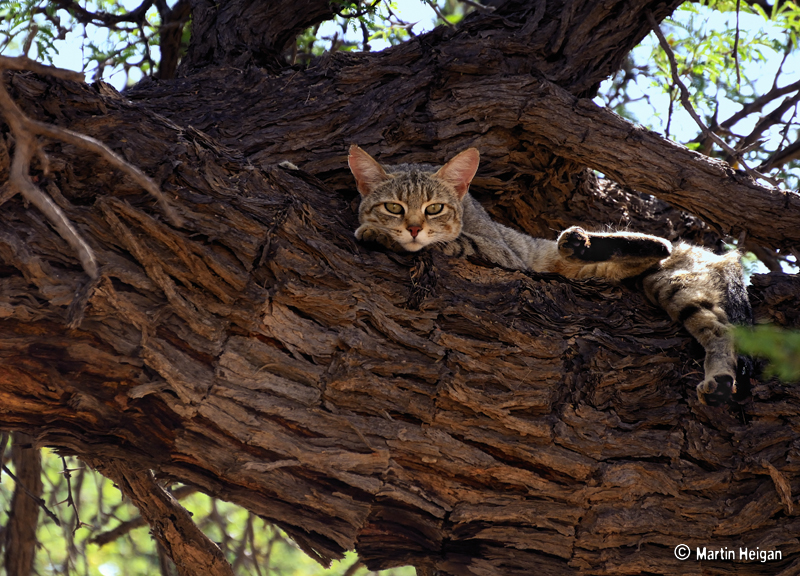
African Wildcat image courtesy of Martin Heigan (Flickr).
Found across the African continent, the African wildcat is also known as a “bush cat.” About 10,000 years ago, some African wildcats were domesticated, which is why they are considered the ancestors of the domestic cat and have many similar features. The smallest of the cats, they primarily eat mice, rats, and other small mammals, though they will also eat birds, reptiles, and insects. Most active during the night and twilight, you’ll rarely see an African wildcat on safari.
How to recognize African wildcats:
During the daytime, African wildcats tend to hide in bushes and wait until dark to hunt. And since they are also solitary, these prolific hunters are hard to spot.
- The body of an African wildcat is similar to a domesticated cat except for their long legs. Size-wise, they weigh between 2.4 – 5.5 kg (5 – 12 lbs).
- African wildcats typically have sandy brown or yellow-gray coats with black stripes on their tails. Their chins and throats are often white with rich, reddish-brown coloring on the back of their ears, belly, and on the back of their legs.
- Look for two dark rings on their forelegs and stripes on their hind legs. Their tails also tend to have two to three rings toward the end with a black tip.
Where can you find African wildcats?
The African wildcat inhabits a wide range of landscapes, but they especially enjoy hilly and mountainous regions. However, they can also be found in deserts as well as in tropical areas, grasslands, scrublands, and more. You’ll have your best chance of seeing an African wildcat on a cloudy day or after dark, during a night drive. They are well adapted to surviving in almost any region.
Black-Footed Cat
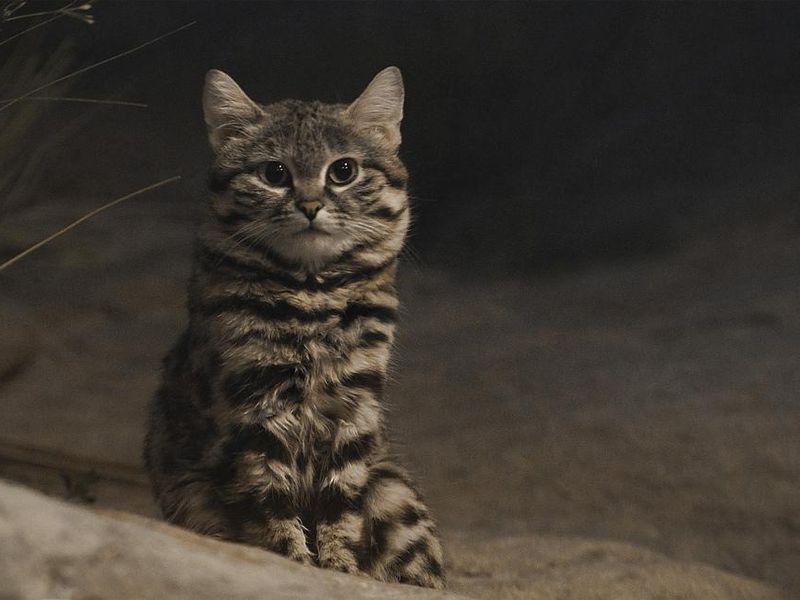
Image courtesy Smithsonian Magazine. They control all copyrights.
The smallest species of wild cats, the black-footed cat is very similar to a domestic cat. However, they are considered the deadliest cat in all of Africa. They respond to the tiniest sounds and have superb night vision, making them incredible hunters. They’ll eat almost anything that moves, including insects, birds, and other small mammals. Exceptional hunters, they stalk their prey in complete silence and then pounce when the time is right.
How to recognize black-footed cats:
Black-footed cats are adorable and look very much like a cuddly domestic cat. They are incredibly rare to see, with no recent records in Botswana.
- Black-footed cats are stocky and compact, weighing between 1.3 – 1.9 kg (2.9 – 4.2 lbs).
- They are recognizable due to their rounded ears, large eyes, and short black-tipped tails.
- Their fur is used as camouflage and is varied in color. However, it’s most often between cinnamon and tawny with patterns of black or brown spots forming rings on the legs, neck, and tail.
Where can you find black-footed cats?
Black-footed cats are found in drier areas of Southern Africa. They prefer deserts of semi-arid regions where there is hot sand and mostly tall grasses and scrubs. As one of Botswana’s cats, this means areas of the Kalahari, Nxai Pan, and Makgadikgadi are their preferred hunting grounds. However, since they are nocturnal, seeing a black-footed cat is incredibly rare, not the least of which is because they are considered “Vulnerable” according to the IUCN Red List of Threatened Animals.
So Many Amazing Botswana Cats
There are so many amazing Botswana cats to see during a safari. To see them all, you’ll have to keep your eyes peeled and have some amazing luck—especially for the smaller species. For lions, leopards, and cheetahs, Botswana is a lush hunting ground. Guests have strong possibilities of discovering a pride of lions or witnessing a lone leopard walking along the road, but with everything in the wild, nothing is guaranteed.
Check back on our blog and our social media regularly to learn more about our recent sightings. And don’t forget to check out our previous Animals of Botswana blogs, including Botswana Antelopes and Africa’s Big 5.
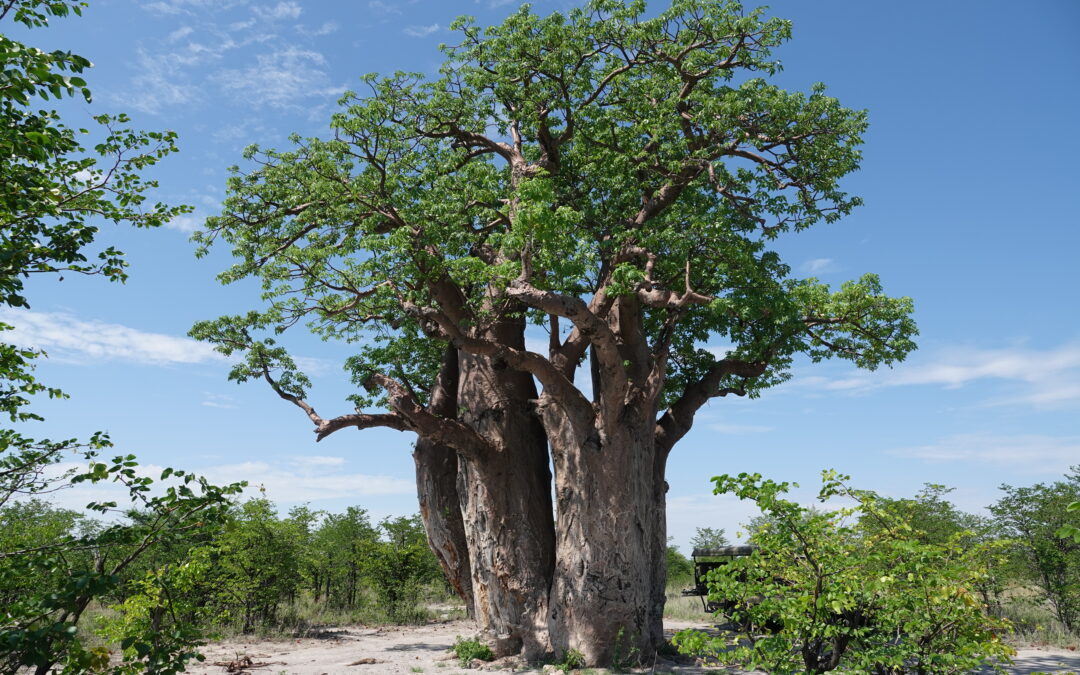
Jan 8, 2020 | Animals of Botswana, Brave Africa Safari, Most Popular Blogs
The first question we get whenever someone begins the booking process with us is, “When should I visit Botswana? Is there a best time of the year to go on safari?” It’s a good question and it depends on where you’re visiting in Botswana. The Kalahari Desert and Okavango Delta are vastly different and respond to the seasons in different ways. We recently had the privilege to experience that difference for ourselves at the end of December.
However, before we delve into our 7-Day/6-Night Kalahari Desert region experience, let’s explain why we tried it out in the first place.
Rainy Season and the Okavango Delta
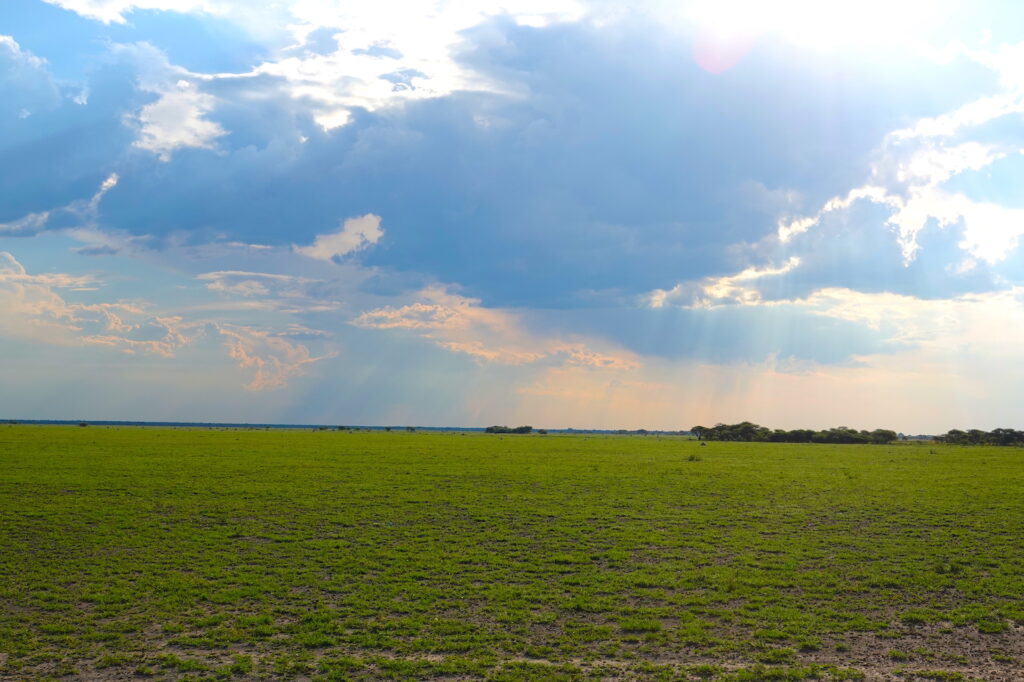
While we’re biased and don’t think there’s ever a truly bad time to go on safari, there are some months that are less than ideal. For example, the rainy season.
From December through March, Botswana becomes a water-flooded wonderland, which is essential for the eco-system of the Delta but can make your safari less enjoyable even with our ponchos to help keep you dry. The good news is that, most often, the rain is in the early morning and evening, which means midday on your all-day game drive should still be beautiful weather.
The main problem with the rainy season is that some sections of the Okavango can become impassible. For example, we cannot offer our typical 10-day safari during the rainy season because the road to get to Savuti is underwater. Instead, we mix it up with more time in Moremi and Khwai.
To combat this rainy season problem, our team wanted to try out something totally different. We decided to test out a new route with three camps around the Kalahari Desert area: Nxai Pan, Makgadikgadi Pans, and Central Kalahari.
Brave Africa and the Kalahari Desert
First: a little Botswana geography lesson.
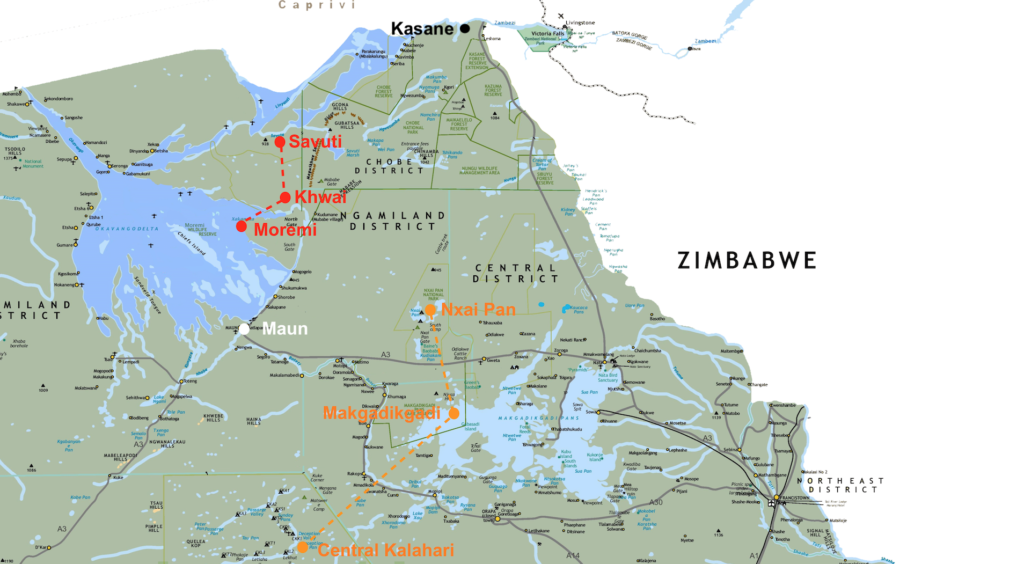
Almost all Brave Africa safaris begin in either Maun or Kasane (Maun for trips beginning via South Africa, Kasane for trips beginning via Victoria Falls). These two airports (in black and white on the map) are your starting points for getting to your safari destination.
The Red Route – Inside the Okavango Delta
For our typical route (the red dots), you would take a bush flight from the airport (Maun or Kasane) to either Savuti or Moremi to begin your safari with us. We would then drive you along the red route (north or south) until you spent three days at each location and really gained a taste of the Delta.
However, as we explained above, Savuti is disconnected from Khwai and Moremi during the rainy season (December – March), so we’re limited to a smaller area of the Okavango. It’s still a great experience since that area is so incredibly wildlife dense, but for some guests, it can be disappointing not to visit Savuti and Chobe National Park.
The Orange Route – Visiting the Kalahari Desert
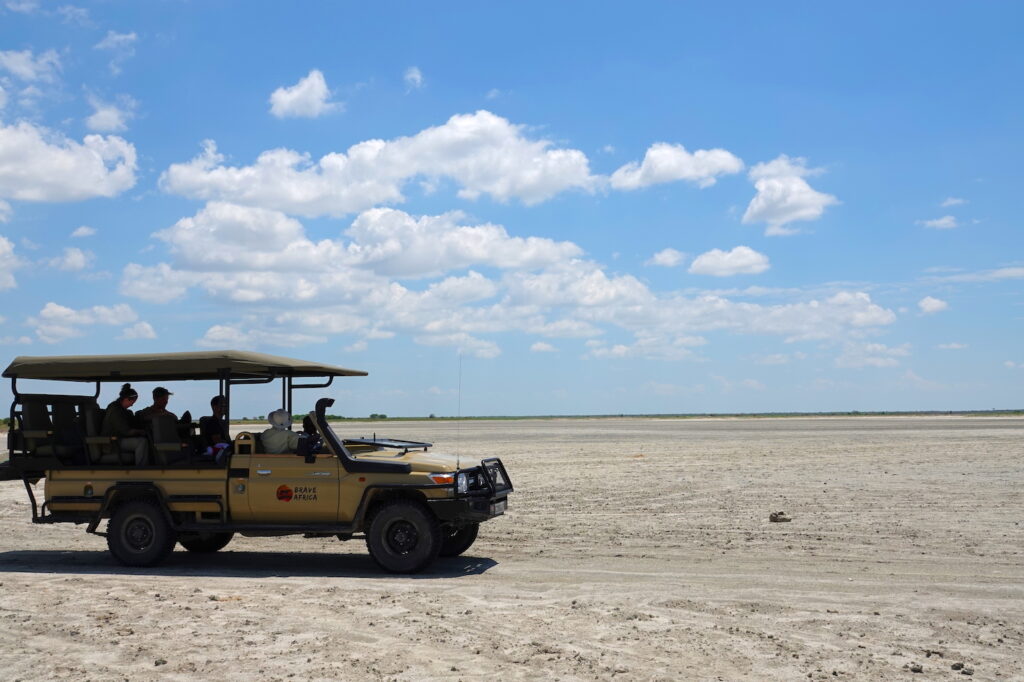
That’s why we decided to try out a new southwestern route, which we’ve outlined in orange: Nxai Pan, Makgadikgadi, and Central Kalahari.
As you can tell right away, this is a much different region of Botswana and that offered quite a surprise for our team. Because of its very dry landscape, the rainy season is actually peak season for these areas, and we had hoped it would offer our guests an exciting alternative to the Okavango Delta without the rain. And that was definitely the case.
During mid-December, when heavy rains hit Maun and the Okavango, we remained fairly dry on in the Kalahari area—only enjoying one amazing thunderstorm. So, the area definitely passed our test for dryness.
However, in the end, it’s not a route we’ll be offering Brave Africa guests any time soon. While there were many things to love, there were also many negatives that we felt would detract too much from a quality safari.
Here’s what we discovered: the good and the bad.
Mobile Safaris in the Kalahari: the Good and the Bad
So, what was it like to go on a mobile safari in the Kalahari region? It was very different from the Okavango in both good and bad ways. Unfortunately, by the end of the trip, we felt the negatives outweighed the positives, at least for us, and here’s why.
GOOD: Unique Animals
Our favorite aspect of visiting the Kalahari region was getting to see unique animals that you don’t find in the Okavango. For example, instead of Impala everywhere, we were overwhelmed with Springbok and Oryx (Gemsbok). These are desert-dwelling antelope that you won’t find in wetter areas. We also saw a ton of Steenbok (the smallest antelope) and even some Red Hartbeest.
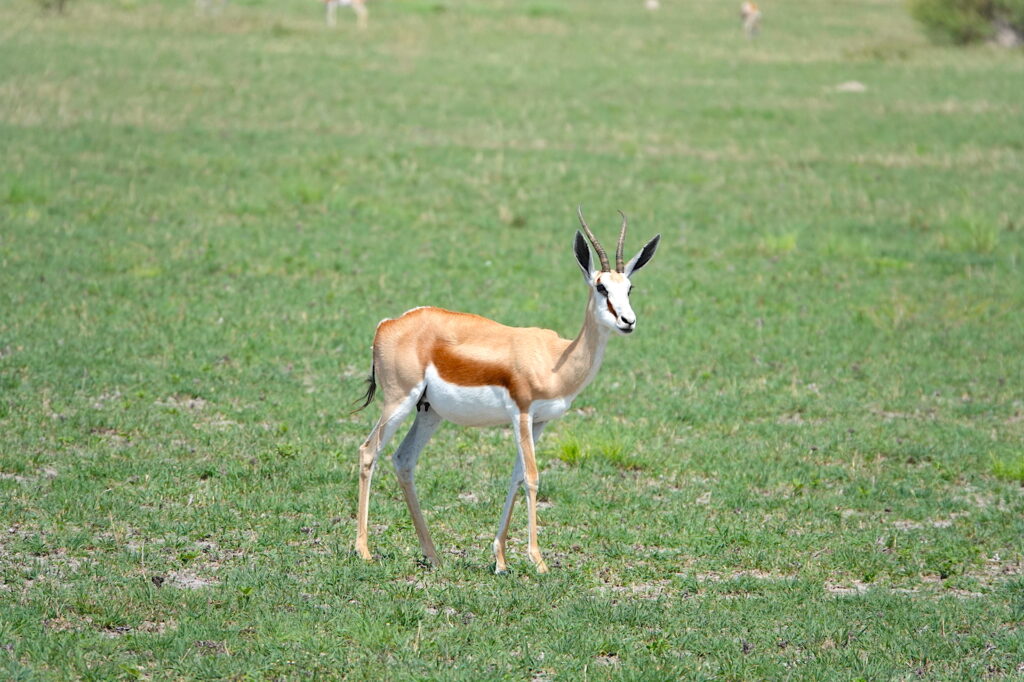
Springbok
On the predator side, these areas are also a haven for black-backed jackals, bat-eared foxes, and highly rare predators such as Brown Hyena. For birds, there are Kori Bustards (the largest flying bird) everywhere, as well as various eagles and hawks and vultures.
This was all very different from what we were used to in the Okavango, which made it exciting.
BAD: Long Travel Days
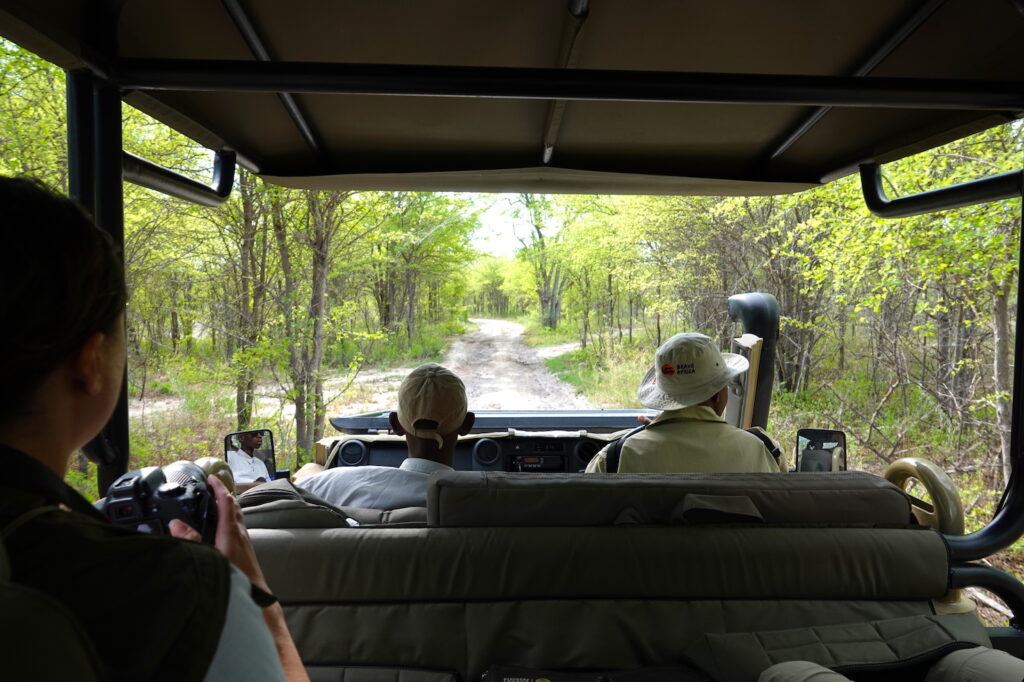
As easily evidenced via the map, going on a mobile safari in the Kalahari area requires a lot more driving between camps. On camp move days, we had to travel over 100 km to get to our next camp and much of that travel was on roads.
This meant that, as a guest, you would not be able to enjoy an all-day safari on camp move days. Instead, you’d be stuck spending a good four to five hours on a dirt road, driving at 50 km/hour, waiting to get to something you can see and enjoy.
The driving between camps was not only taxing on our guests, but it was incredibly difficult for our staff. Trying to get all of our ultra-luxury camp supplies to the next location in time and safely was a chore.
GOOD: Mesmerizing Landscapes
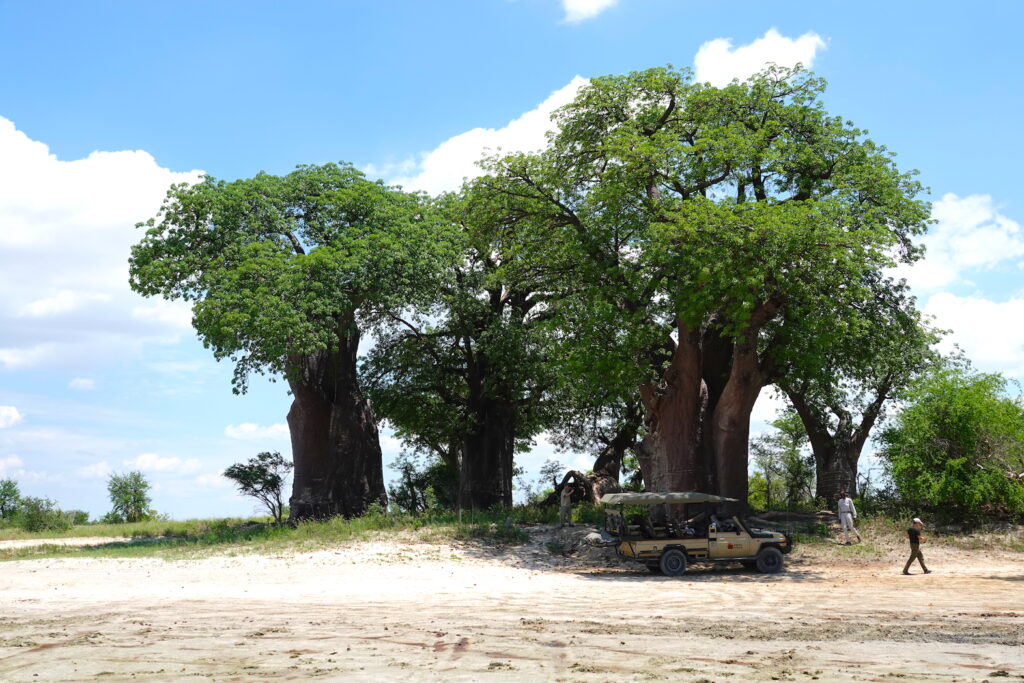
Baines Baobab
Every day on our 6-night safari in the Kalahari region, someone in the Land Cruiser would say “Wow!” when it came to the scenery. We were all so used to seeing rivers, Mopani forests, and sweeping grasslands in the Okavango, that to see desert salt pans as far as the eye could see was something else.
There were a few areas, such as Baines Baobab, that literally took our breaths away. It felt like we were on a completely different planet. It was hard to imagine things living in such harsh but beautiful landscapes, and we thoroughly enjoyed the scenery.
In particular, we all loved the many Baobab trees, which could be found throughout Nxai Pan. Every time we saw one, we had to stop and enjoy its beauty, shade, and majesty.
BAD: Low Animal Density
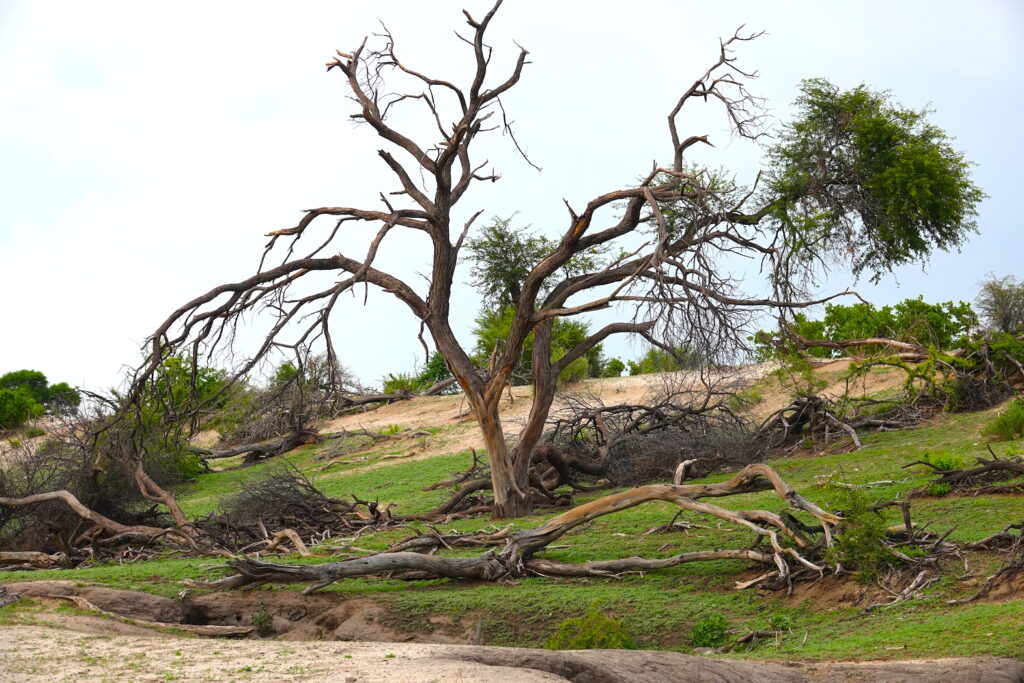
If you’ve ever taken a Botswana safari in the Okavango, you know that animals are everywhere. You won’t be with lions, leopards, or wild dogs constantly, but there’s a fairly regular stream of antelope, elephants, buffalo, wildebeest, and more. You won’t go more than an hour without seeing something in the Delta.
In the Kalahari, there were times that we drove for hours and hours without a single sign of wildlife. No birds, no antelope, nothing. The peace was incredible. We were seriously on our own for hours at a time, but if you’re going to Botswana to see the animals, this area could be fairly disappointing.
For example, in our seven days on safari, we only saw elephants twice and we only ever saw Bulls; we never saw a breeding herd. And in Makgadikgadi, it’s unfortunate to say, but we saw more corpses and livestock than Botswana wildlife.
GOOD: Fewer Tourists
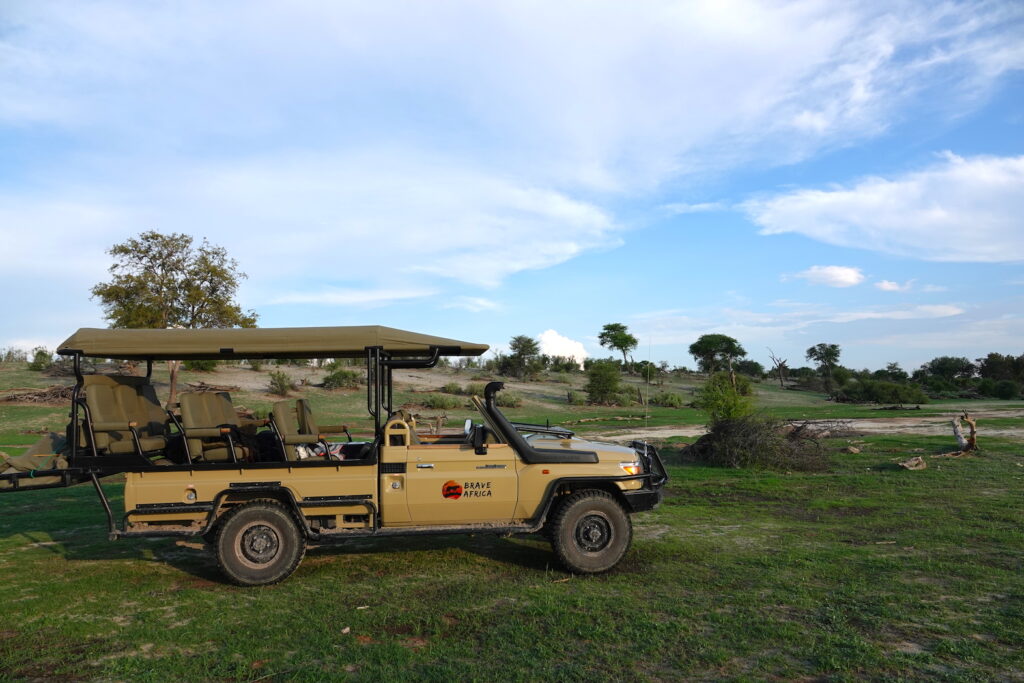
If you’re looking to get off the beaten track, the Kalahari region is the area for you. In both Nxai Pan and Makgadikgadi we rarely, if ever, saw another car. We were alone in the parks and able to explore as much as we wanted without having to worry about any other camps or self-drive vehicles.
Central Kalahari had more camps, but still far fewer than you’ll have in the Okavango. We still went hours without seeing another soul.
BAD: Heat
There’s hot and then there’s hot. Imagine 35 degrees Celsius (95F) with no shade around, no water to cool things down, just unrelenting sun and heat. There were times that we didn’t stop for lunch until 3 pm because we couldn’t find a single tree tall enough to offer shade to eat.
At least in the Okavango, there’s always a river, marsh, or watering hole nearby to offer a reprieve from the summer heat. In the Kalahari, you have to be willing to brave locations where there’s not a single plant above waste high for as far as the eye can see.
Going on Safari in the Kalahari Desert – Final Thoughts

In the end, while we enjoyed our time on safari in the Kalahari region, it is not a location we think our guests would enjoy as much as the Okavango. For first-time safari-goers or safari enthusiasts who are visiting Botswana for their first or second time, the Okavango Delta is a much better choice. There’s more diverse wildlife and denser populations of wildlife.
However, we definitely recommend that you take the time to visit a camp in the Kalahari region and spend two-to-three days exploring. The pans should not be missed and there are many great camps in this region where you can fly in and fly-out before joining up with Brave Africa for the remainder of your safari in the Okavango.
In particular, we recommend Nxai Pan and Central Kalahari. For example, African Bush Camps offers a unique Migration Expeditions in Nxai Pan solely during the rainy season.
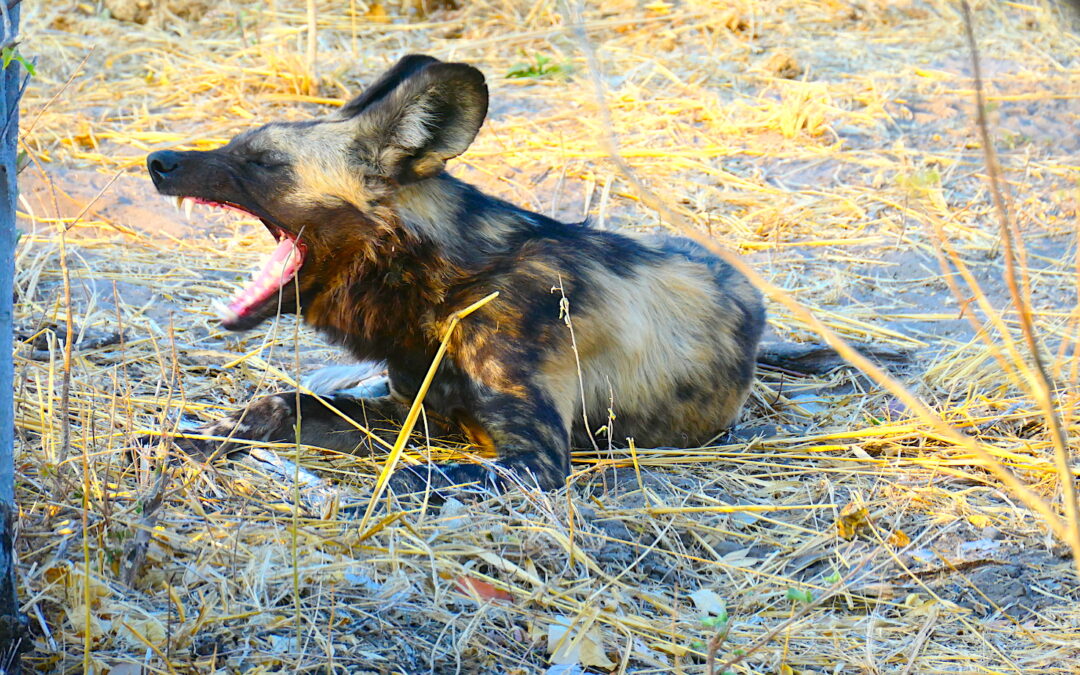
Nov 2, 2019 | Adventure Safari, Animals of Botswana, Brave Africa Safari, Game Drive
On a safari in Botswana in Brave Africa, there’s always something new to experience. We never know what we’re going to see on a game drive, but we know it’s always going to be something exciting as long as we’re open to the possibilities. This time it was a pack of wild dogs hunting.
On our most recent trip out to Xakanaxa (Moremi Game Reserve), even our staff got to join in on the excitement when at least two-dozen wild dogs, including four puppies, hunted an impala at camp.
Wild Dogs at Camp
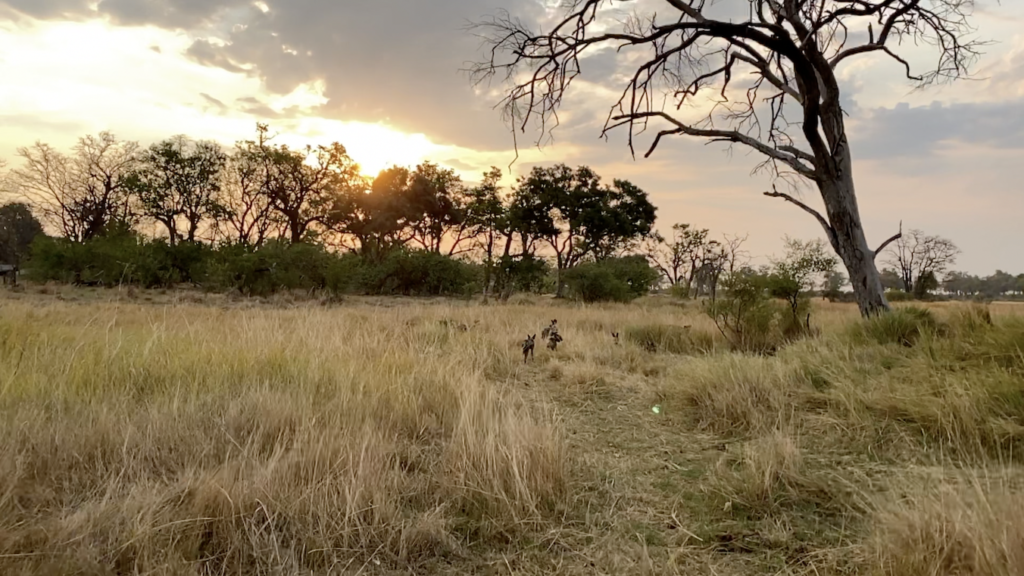
Wild dog pack of about two-dozen dogs hanging out at the Brave Africa camp in the Moremi Game Reserve.
After a wonderful all-day game drive, Wina and our guests were heading back to camp for dinner when they ran right into a huge pack of wild dogs. We were barely a hundred meters from camp. You could see the staff tents, our moving trucks, and the main tent, and yet right there in front of us, there had to be about two dozen wild dogs all walking along in the setting sun, including four puppies—around six months old.
They had just woken up from their afternoon nap and were on the hunt.
With a pack that large—more than twenty dogs—hunting enough food for everyone is a challenge. The pack has to kill multiple times a day to stay healthy, and that can be especially difficult with pups. The pups always have to be protected, but they also have to learn how to hunt, so it’s a fascinating balancing act.
When we first came upon them, the pack was slowly meandering along. They were spread out and looking for food, but nothing urgent. The pups were toward the back, bouncing along, with assigned minders to make sure they kept up and didn’t get into too much trouble. And the rest of the pack was in formation, looking for prey.
Then, between one moment and the next, everything changed.
Wild Dogs Hunt at Brave Africa
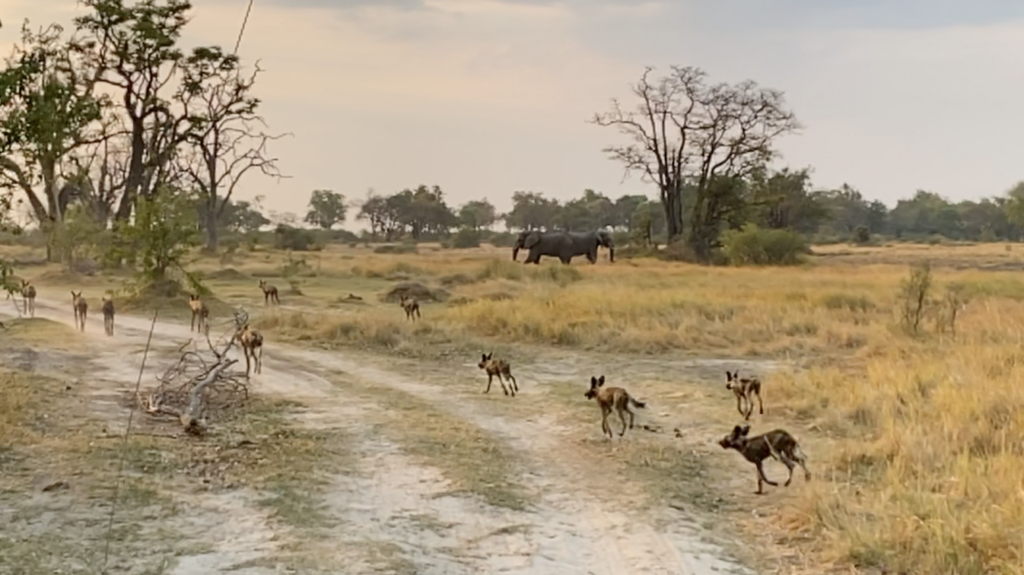
The wild dog pack prepares to hunt.
Suddenly, we heard some high-pitched squeaking. It was the dogs sending out a warning call about nearby prey. It seemed like we blinked, and then there was an impala on the move.
She was in the wrong place, at the wrong time. No lone animal would stand a chance surrounded by more than 20 hungry dogs, and neither did she. While she leaped and ran as fast as she could, she wasn’t fast enough.
The wild dogs won.
Only a few of the pack actually went to the kill site, the rest stayed back with the puppies, and so did we. The puppies didn’t have the energy to keep up with the adults on the hunt, and we didn’t have the speed, but in this case, waiting behind was not a problem.
While we didn’t witness the kill, a few minutes later, we saw something just as special.
Wild Dogs Taking Care of Puppies
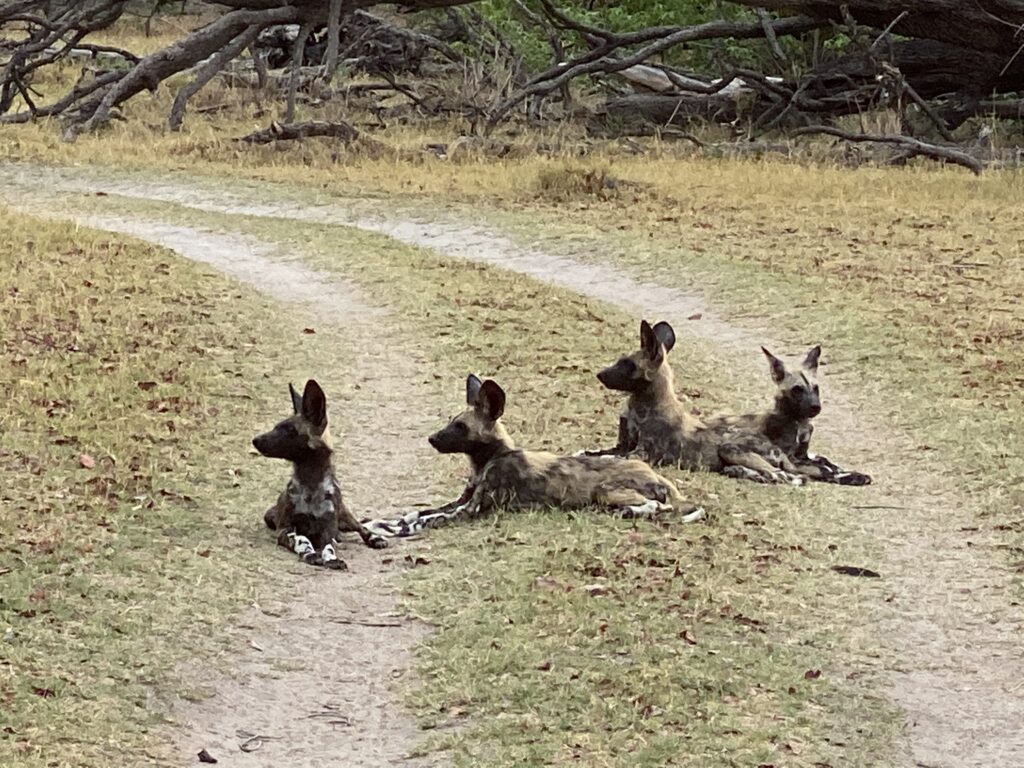
Four wild dog puppies waiting for the adults to come pack with food.
Wild dogs are incredibly social creatures. They are all about the pack. No dog is left behind, and every pup is well cared for, and we got to witness this first-hand.
Since the puppies were too young to hunt, the adults brought the kill to them. No, they didn’t drag over the kill like lions would do. They also didn’t force the puppies to move to the kill site—that would be too dangerous. Instead, the adults took turns eating and regurgitating food for the puppies.
That’s right. We got to witness wild dogs vomiting pre-chewed and swallowed food so the puppies could enjoy.
It was ADORABLE. And no, we’re not joking.
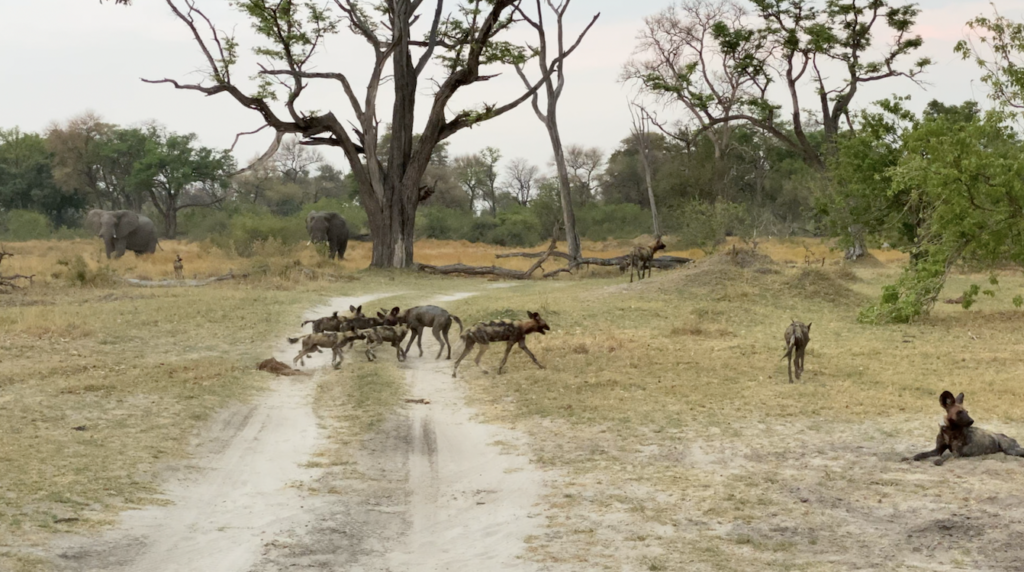
Wild dog puppies eating regurgitated impala thanks to a successful hunt.
It was astonishing to see the family dynamics. The four puppies stayed together, and every time an adult came back from the kill site, they immediately went up to the puppies and regurgitated enough for a meal.
The puppies squeaked and squealed and ate their dinner happily until the next adult would come back. They did this over and over again until the puppies were full, and the kill was demolished.
Wild Dogs and Brave Africa Staff
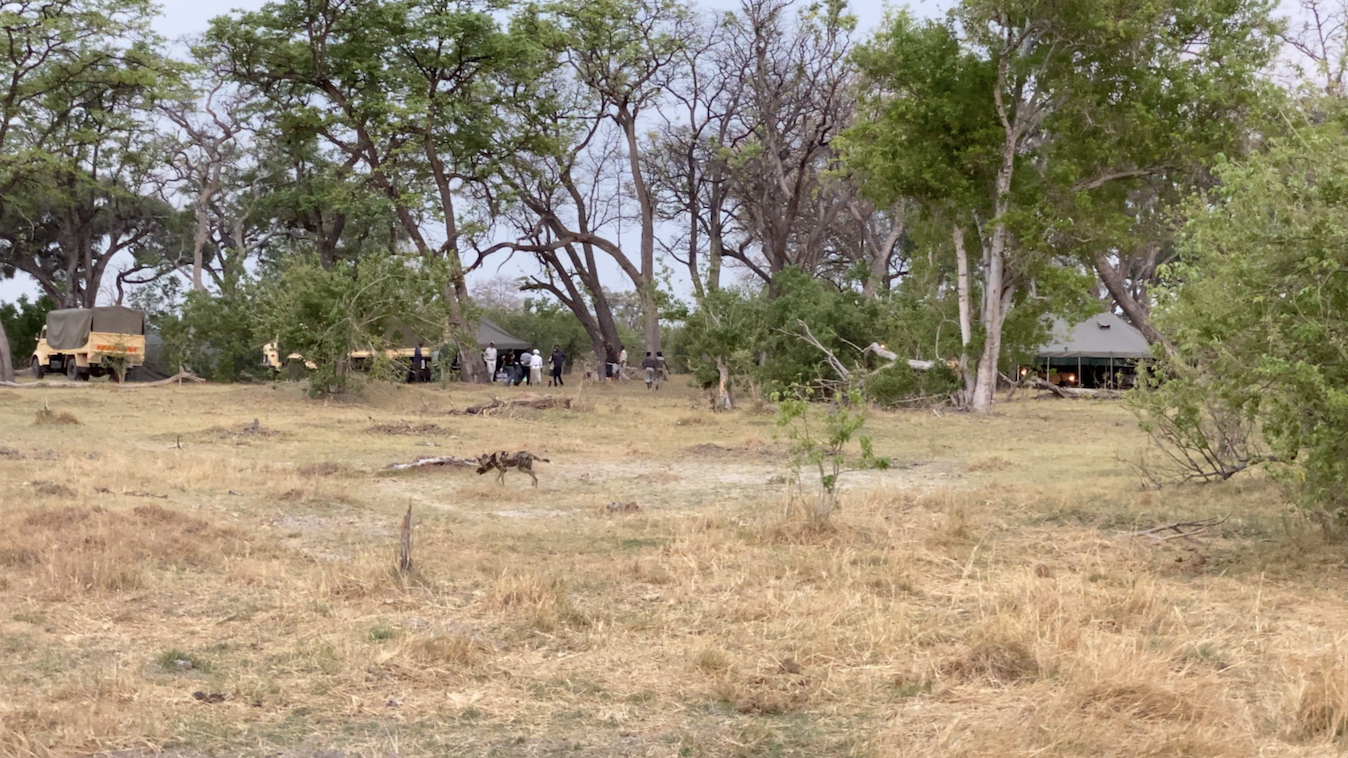
All the Brave Africa staff came out to watch the wild dogs hunt. You can see our main “mess” tent on the far right with our staff tents and moving vehicles on the left.
For some of our Brave Africa staff, it was the first time they’d ever seen a pack of wild dogs. While they’re out in the bush regularly, they mostly stay at camp. This means they’ve all seen elephants and various antelope, but predators are always rare, and they’re especially rare if you remain at camp and don’t go looking for them.
This time, the staff didn’t have to go on a game drive to experience something that is incredibly rare and exciting. All they had to do is stand at the edge of camp and watch. It was thrilling, and something we’ll be talking about for years.
Watch the wild dogs hunt for yourself!






































